Public Procurement Law - Assignment
VerifiedAdded on 2022/08/19
|19
|5181
|15
Assignment
AI Summary
Contribute Materials
Your contribution can guide someone’s learning journey. Share your
documents today.
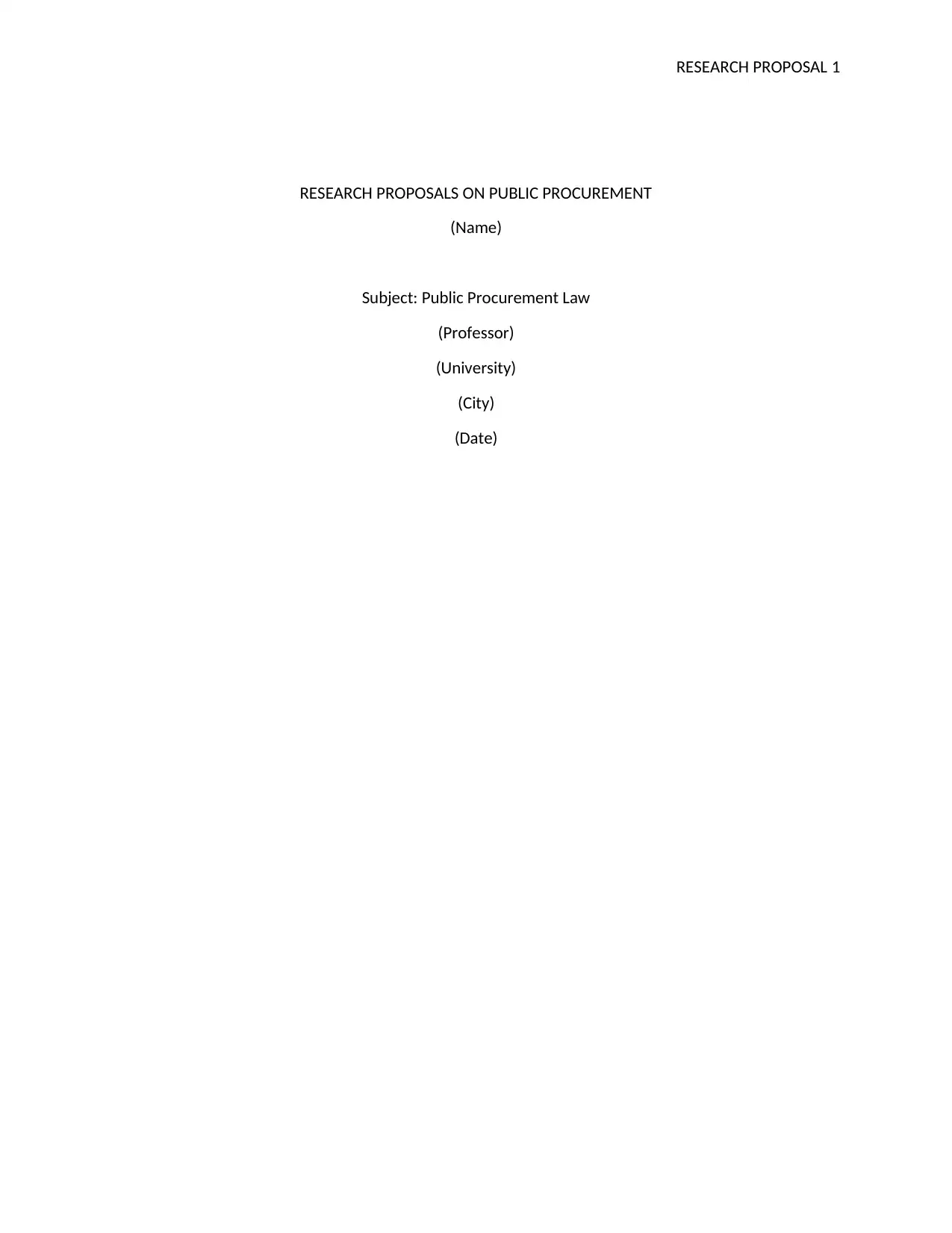
RESEARCH PROPOSAL 1
RESEARCH PROPOSALS ON PUBLIC PROCUREMENT
(Name)
Subject: Public Procurement Law
(Professor)
(University)
(City)
(Date)
RESEARCH PROPOSALS ON PUBLIC PROCUREMENT
(Name)
Subject: Public Procurement Law
(Professor)
(University)
(City)
(Date)
Secure Best Marks with AI Grader
Need help grading? Try our AI Grader for instant feedback on your assignments.
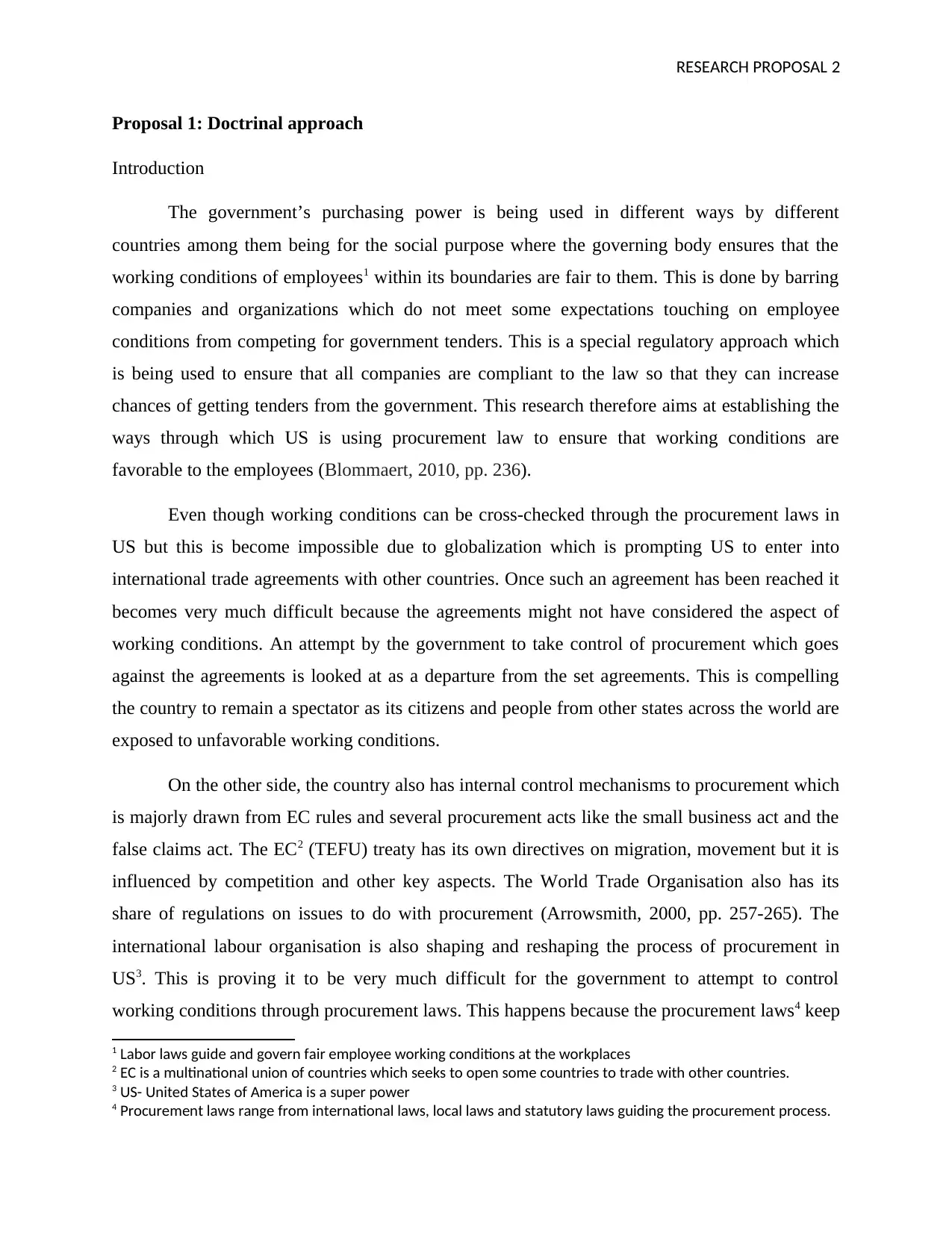
RESEARCH PROPOSAL 2
Proposal 1: Doctrinal approach
Introduction
The government’s purchasing power is being used in different ways by different
countries among them being for the social purpose where the governing body ensures that the
working conditions of employees1 within its boundaries are fair to them. This is done by barring
companies and organizations which do not meet some expectations touching on employee
conditions from competing for government tenders. This is a special regulatory approach which
is being used to ensure that all companies are compliant to the law so that they can increase
chances of getting tenders from the government. This research therefore aims at establishing the
ways through which US is using procurement law to ensure that working conditions are
favorable to the employees (Blommaert, 2010, pp. 236).
Even though working conditions can be cross-checked through the procurement laws in
US but this is become impossible due to globalization which is prompting US to enter into
international trade agreements with other countries. Once such an agreement has been reached it
becomes very much difficult because the agreements might not have considered the aspect of
working conditions. An attempt by the government to take control of procurement which goes
against the agreements is looked at as a departure from the set agreements. This is compelling
the country to remain a spectator as its citizens and people from other states across the world are
exposed to unfavorable working conditions.
On the other side, the country also has internal control mechanisms to procurement which
is majorly drawn from EC rules and several procurement acts like the small business act and the
false claims act. The EC2 (TEFU) treaty has its own directives on migration, movement but it is
influenced by competition and other key aspects. The World Trade Organisation also has its
share of regulations on issues to do with procurement (Arrowsmith, 2000, pp. 257-265). The
international labour organisation is also shaping and reshaping the process of procurement in
US3. This is proving it to be very much difficult for the government to attempt to control
working conditions through procurement laws. This happens because the procurement laws4 keep
1 Labor laws guide and govern fair employee working conditions at the workplaces
2 EC is a multinational union of countries which seeks to open some countries to trade with other countries.
3 US- United States of America is a super power
4 Procurement laws range from international laws, local laws and statutory laws guiding the procurement process.
Proposal 1: Doctrinal approach
Introduction
The government’s purchasing power is being used in different ways by different
countries among them being for the social purpose where the governing body ensures that the
working conditions of employees1 within its boundaries are fair to them. This is done by barring
companies and organizations which do not meet some expectations touching on employee
conditions from competing for government tenders. This is a special regulatory approach which
is being used to ensure that all companies are compliant to the law so that they can increase
chances of getting tenders from the government. This research therefore aims at establishing the
ways through which US is using procurement law to ensure that working conditions are
favorable to the employees (Blommaert, 2010, pp. 236).
Even though working conditions can be cross-checked through the procurement laws in
US but this is become impossible due to globalization which is prompting US to enter into
international trade agreements with other countries. Once such an agreement has been reached it
becomes very much difficult because the agreements might not have considered the aspect of
working conditions. An attempt by the government to take control of procurement which goes
against the agreements is looked at as a departure from the set agreements. This is compelling
the country to remain a spectator as its citizens and people from other states across the world are
exposed to unfavorable working conditions.
On the other side, the country also has internal control mechanisms to procurement which
is majorly drawn from EC rules and several procurement acts like the small business act and the
false claims act. The EC2 (TEFU) treaty has its own directives on migration, movement but it is
influenced by competition and other key aspects. The World Trade Organisation also has its
share of regulations on issues to do with procurement (Arrowsmith, 2000, pp. 257-265). The
international labour organisation is also shaping and reshaping the process of procurement in
US3. This is proving it to be very much difficult for the government to attempt to control
working conditions through procurement laws. This happens because the procurement laws4 keep
1 Labor laws guide and govern fair employee working conditions at the workplaces
2 EC is a multinational union of countries which seeks to open some countries to trade with other countries.
3 US- United States of America is a super power
4 Procurement laws range from international laws, local laws and statutory laws guiding the procurement process.
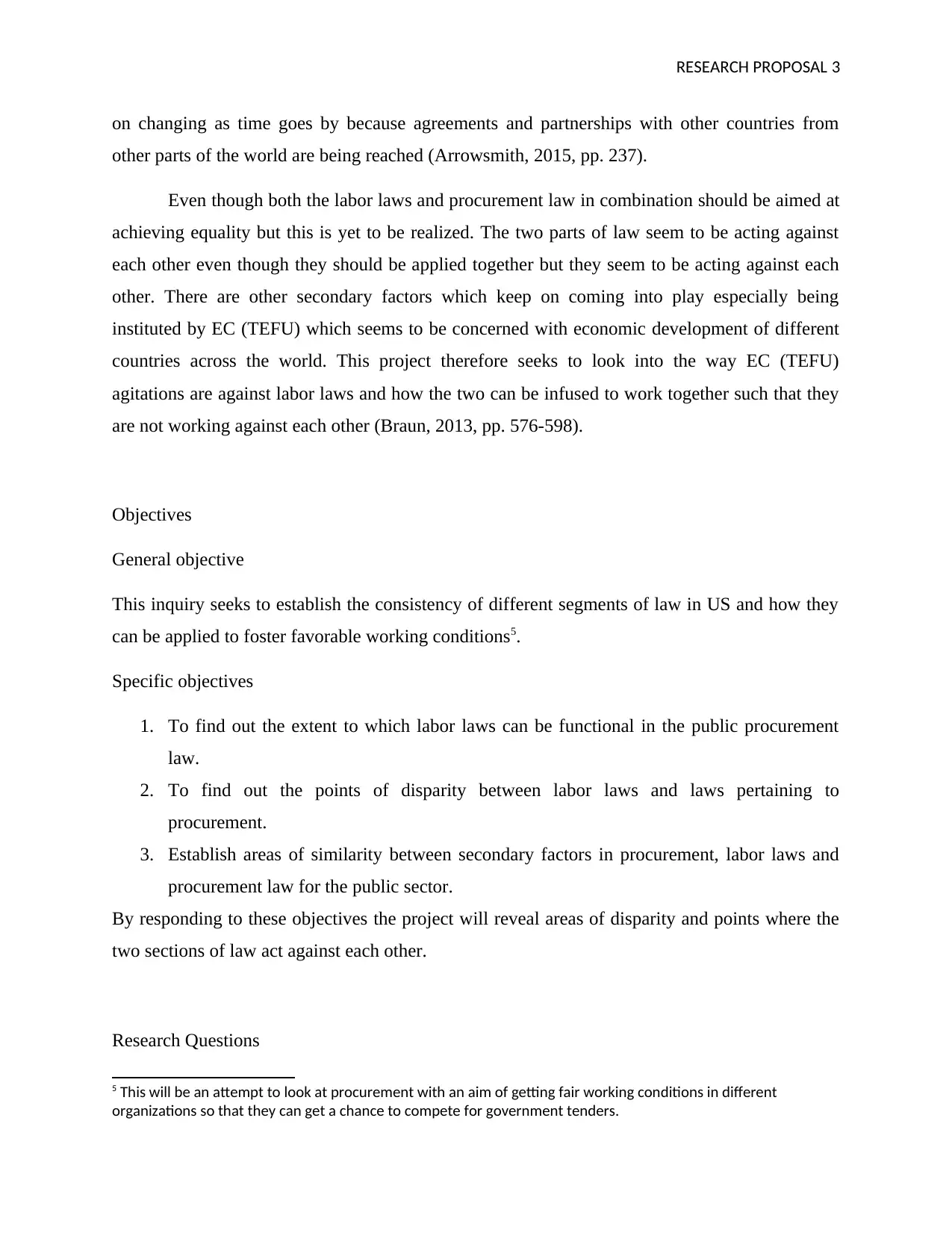
RESEARCH PROPOSAL 3
on changing as time goes by because agreements and partnerships with other countries from
other parts of the world are being reached (Arrowsmith, 2015, pp. 237).
Even though both the labor laws and procurement law in combination should be aimed at
achieving equality but this is yet to be realized. The two parts of law seem to be acting against
each other even though they should be applied together but they seem to be acting against each
other. There are other secondary factors which keep on coming into play especially being
instituted by EC (TEFU) which seems to be concerned with economic development of different
countries across the world. This project therefore seeks to look into the way EC (TEFU)
agitations are against labor laws and how the two can be infused to work together such that they
are not working against each other (Braun, 2013, pp. 576-598).
Objectives
General objective
This inquiry seeks to establish the consistency of different segments of law in US and how they
can be applied to foster favorable working conditions5.
Specific objectives
1. To find out the extent to which labor laws can be functional in the public procurement
law.
2. To find out the points of disparity between labor laws and laws pertaining to
procurement.
3. Establish areas of similarity between secondary factors in procurement, labor laws and
procurement law for the public sector.
By responding to these objectives the project will reveal areas of disparity and points where the
two sections of law act against each other.
Research Questions
5 This will be an attempt to look at procurement with an aim of getting fair working conditions in different
organizations so that they can get a chance to compete for government tenders.
on changing as time goes by because agreements and partnerships with other countries from
other parts of the world are being reached (Arrowsmith, 2015, pp. 237).
Even though both the labor laws and procurement law in combination should be aimed at
achieving equality but this is yet to be realized. The two parts of law seem to be acting against
each other even though they should be applied together but they seem to be acting against each
other. There are other secondary factors which keep on coming into play especially being
instituted by EC (TEFU) which seems to be concerned with economic development of different
countries across the world. This project therefore seeks to look into the way EC (TEFU)
agitations are against labor laws and how the two can be infused to work together such that they
are not working against each other (Braun, 2013, pp. 576-598).
Objectives
General objective
This inquiry seeks to establish the consistency of different segments of law in US and how they
can be applied to foster favorable working conditions5.
Specific objectives
1. To find out the extent to which labor laws can be functional in the public procurement
law.
2. To find out the points of disparity between labor laws and laws pertaining to
procurement.
3. Establish areas of similarity between secondary factors in procurement, labor laws and
procurement law for the public sector.
By responding to these objectives the project will reveal areas of disparity and points where the
two sections of law act against each other.
Research Questions
5 This will be an attempt to look at procurement with an aim of getting fair working conditions in different
organizations so that they can get a chance to compete for government tenders.
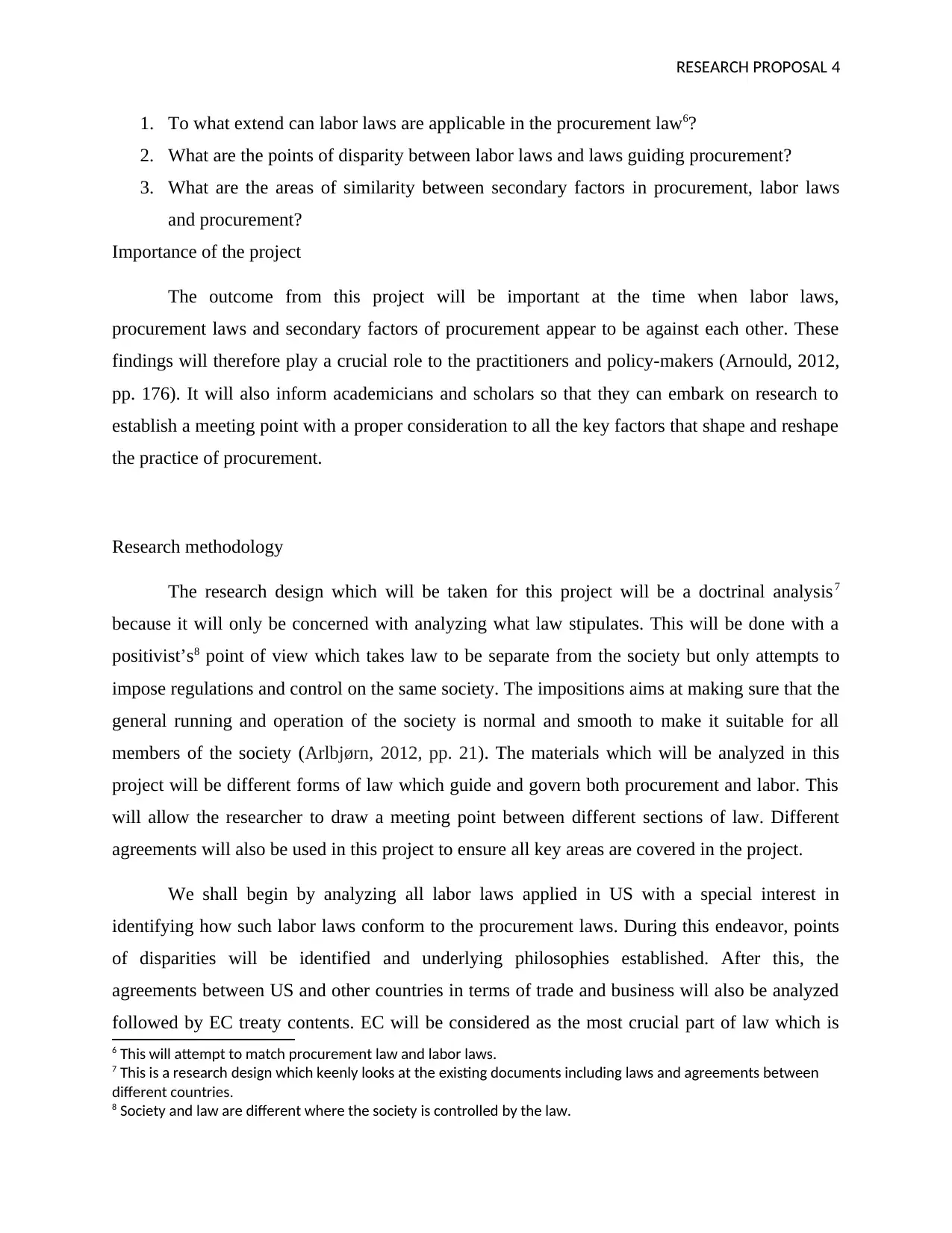
RESEARCH PROPOSAL 4
1. To what extend can labor laws are applicable in the procurement law6?
2. What are the points of disparity between labor laws and laws guiding procurement?
3. What are the areas of similarity between secondary factors in procurement, labor laws
and procurement?
Importance of the project
The outcome from this project will be important at the time when labor laws,
procurement laws and secondary factors of procurement appear to be against each other. These
findings will therefore play a crucial role to the practitioners and policy-makers (Arnould, 2012,
pp. 176). It will also inform academicians and scholars so that they can embark on research to
establish a meeting point with a proper consideration to all the key factors that shape and reshape
the practice of procurement.
Research methodology
The research design which will be taken for this project will be a doctrinal analysis7
because it will only be concerned with analyzing what law stipulates. This will be done with a
positivist’s8 point of view which takes law to be separate from the society but only attempts to
impose regulations and control on the same society. The impositions aims at making sure that the
general running and operation of the society is normal and smooth to make it suitable for all
members of the society (Arlbjørn, 2012, pp. 21). The materials which will be analyzed in this
project will be different forms of law which guide and govern both procurement and labor. This
will allow the researcher to draw a meeting point between different sections of law. Different
agreements will also be used in this project to ensure all key areas are covered in the project.
We shall begin by analyzing all labor laws applied in US with a special interest in
identifying how such labor laws conform to the procurement laws. During this endeavor, points
of disparities will be identified and underlying philosophies established. After this, the
agreements between US and other countries in terms of trade and business will also be analyzed
followed by EC treaty contents. EC will be considered as the most crucial part of law which is
6 This will attempt to match procurement law and labor laws.
7 This is a research design which keenly looks at the existing documents including laws and agreements between
different countries.
8 Society and law are different where the society is controlled by the law.
1. To what extend can labor laws are applicable in the procurement law6?
2. What are the points of disparity between labor laws and laws guiding procurement?
3. What are the areas of similarity between secondary factors in procurement, labor laws
and procurement?
Importance of the project
The outcome from this project will be important at the time when labor laws,
procurement laws and secondary factors of procurement appear to be against each other. These
findings will therefore play a crucial role to the practitioners and policy-makers (Arnould, 2012,
pp. 176). It will also inform academicians and scholars so that they can embark on research to
establish a meeting point with a proper consideration to all the key factors that shape and reshape
the practice of procurement.
Research methodology
The research design which will be taken for this project will be a doctrinal analysis7
because it will only be concerned with analyzing what law stipulates. This will be done with a
positivist’s8 point of view which takes law to be separate from the society but only attempts to
impose regulations and control on the same society. The impositions aims at making sure that the
general running and operation of the society is normal and smooth to make it suitable for all
members of the society (Arlbjørn, 2012, pp. 21). The materials which will be analyzed in this
project will be different forms of law which guide and govern both procurement and labor. This
will allow the researcher to draw a meeting point between different sections of law. Different
agreements will also be used in this project to ensure all key areas are covered in the project.
We shall begin by analyzing all labor laws applied in US with a special interest in
identifying how such labor laws conform to the procurement laws. During this endeavor, points
of disparities will be identified and underlying philosophies established. After this, the
agreements between US and other countries in terms of trade and business will also be analyzed
followed by EC treaty contents. EC will be considered as the most crucial part of law which is
6 This will attempt to match procurement law and labor laws.
7 This is a research design which keenly looks at the existing documents including laws and agreements between
different countries.
8 Society and law are different where the society is controlled by the law.
Secure Best Marks with AI Grader
Need help grading? Try our AI Grader for instant feedback on your assignments.
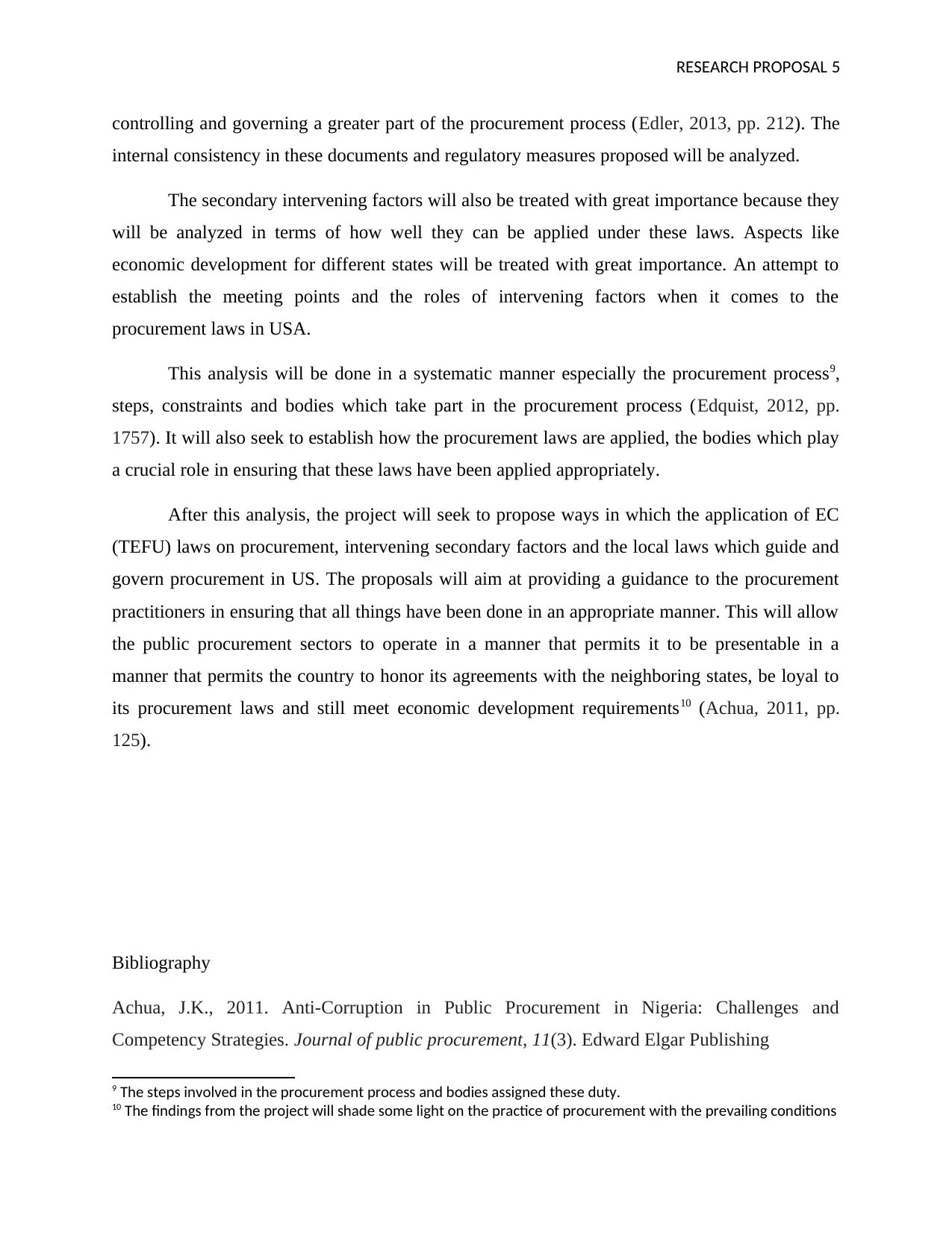
RESEARCH PROPOSAL 5
controlling and governing a greater part of the procurement process (Edler, 2013, pp. 212). The
internal consistency in these documents and regulatory measures proposed will be analyzed.
The secondary intervening factors will also be treated with great importance because they
will be analyzed in terms of how well they can be applied under these laws. Aspects like
economic development for different states will be treated with great importance. An attempt to
establish the meeting points and the roles of intervening factors when it comes to the
procurement laws in USA.
This analysis will be done in a systematic manner especially the procurement process9,
steps, constraints and bodies which take part in the procurement process (Edquist, 2012, pp.
1757). It will also seek to establish how the procurement laws are applied, the bodies which play
a crucial role in ensuring that these laws have been applied appropriately.
After this analysis, the project will seek to propose ways in which the application of EC
(TEFU) laws on procurement, intervening secondary factors and the local laws which guide and
govern procurement in US. The proposals will aim at providing a guidance to the procurement
practitioners in ensuring that all things have been done in an appropriate manner. This will allow
the public procurement sectors to operate in a manner that permits it to be presentable in a
manner that permits the country to honor its agreements with the neighboring states, be loyal to
its procurement laws and still meet economic development requirements10 (Achua, 2011, pp.
125).
Bibliography
Achua, J.K., 2011. Anti-Corruption in Public Procurement in Nigeria: Challenges and
Competency Strategies. Journal of public procurement, 11(3). Edward Elgar Publishing
9 The steps involved in the procurement process and bodies assigned these duty.
10 The findings from the project will shade some light on the practice of procurement with the prevailing conditions
controlling and governing a greater part of the procurement process (Edler, 2013, pp. 212). The
internal consistency in these documents and regulatory measures proposed will be analyzed.
The secondary intervening factors will also be treated with great importance because they
will be analyzed in terms of how well they can be applied under these laws. Aspects like
economic development for different states will be treated with great importance. An attempt to
establish the meeting points and the roles of intervening factors when it comes to the
procurement laws in USA.
This analysis will be done in a systematic manner especially the procurement process9,
steps, constraints and bodies which take part in the procurement process (Edquist, 2012, pp.
1757). It will also seek to establish how the procurement laws are applied, the bodies which play
a crucial role in ensuring that these laws have been applied appropriately.
After this analysis, the project will seek to propose ways in which the application of EC
(TEFU) laws on procurement, intervening secondary factors and the local laws which guide and
govern procurement in US. The proposals will aim at providing a guidance to the procurement
practitioners in ensuring that all things have been done in an appropriate manner. This will allow
the public procurement sectors to operate in a manner that permits it to be presentable in a
manner that permits the country to honor its agreements with the neighboring states, be loyal to
its procurement laws and still meet economic development requirements10 (Achua, 2011, pp.
125).
Bibliography
Achua, J.K., 2011. Anti-Corruption in Public Procurement in Nigeria: Challenges and
Competency Strategies. Journal of public procurement, 11(3). Edward Elgar Publishing
9 The steps involved in the procurement process and bodies assigned these duty.
10 The findings from the project will shade some light on the practice of procurement with the prevailing conditions
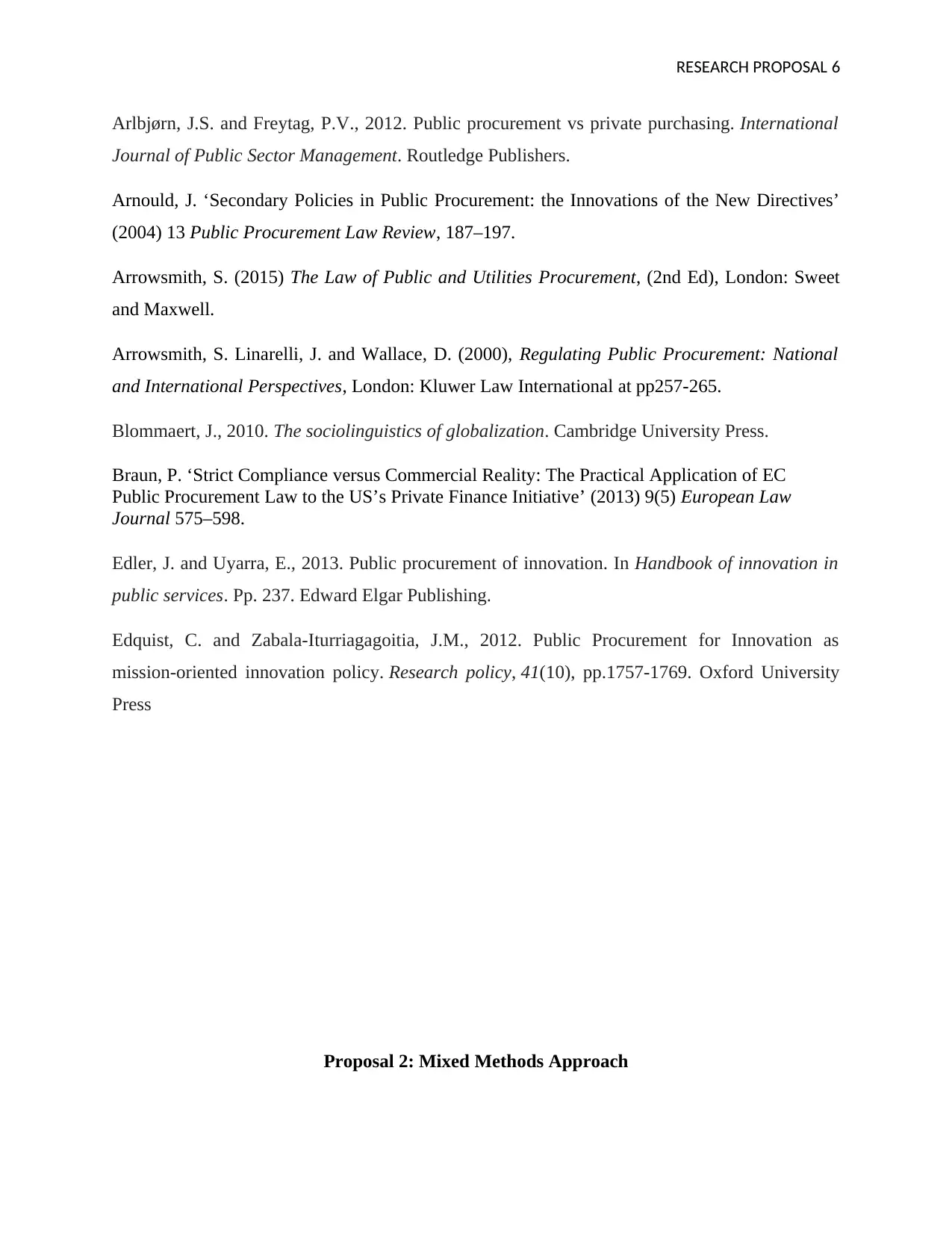
RESEARCH PROPOSAL 6
Arlbjørn, J.S. and Freytag, P.V., 2012. Public procurement vs private purchasing. International
Journal of Public Sector Management. Routledge Publishers.
Arnould, J. ‘Secondary Policies in Public Procurement: the Innovations of the New Directives’
(2004) 13 Public Procurement Law Review, 187–197.
Arrowsmith, S. (2015) The Law of Public and Utilities Procurement, (2nd Ed), London: Sweet
and Maxwell.
Arrowsmith, S. Linarelli, J. and Wallace, D. (2000), Regulating Public Procurement: National
and International Perspectives, London: Kluwer Law International at pp257-265.
Blommaert, J., 2010. The sociolinguistics of globalization. Cambridge University Press.
Braun, P. ‘Strict Compliance versus Commercial Reality: The Practical Application of EC
Public Procurement Law to the US’s Private Finance Initiative’ (2013) 9(5) European Law
Journal 575–598.
Edler, J. and Uyarra, E., 2013. Public procurement of innovation. In Handbook of innovation in
public services. Pp. 237. Edward Elgar Publishing.
Edquist, C. and Zabala-Iturriagagoitia, J.M., 2012. Public Procurement for Innovation as
mission-oriented innovation policy. Research policy, 41(10), pp.1757-1769. Oxford University
Press
Proposal 2: Mixed Methods Approach
Arlbjørn, J.S. and Freytag, P.V., 2012. Public procurement vs private purchasing. International
Journal of Public Sector Management. Routledge Publishers.
Arnould, J. ‘Secondary Policies in Public Procurement: the Innovations of the New Directives’
(2004) 13 Public Procurement Law Review, 187–197.
Arrowsmith, S. (2015) The Law of Public and Utilities Procurement, (2nd Ed), London: Sweet
and Maxwell.
Arrowsmith, S. Linarelli, J. and Wallace, D. (2000), Regulating Public Procurement: National
and International Perspectives, London: Kluwer Law International at pp257-265.
Blommaert, J., 2010. The sociolinguistics of globalization. Cambridge University Press.
Braun, P. ‘Strict Compliance versus Commercial Reality: The Practical Application of EC
Public Procurement Law to the US’s Private Finance Initiative’ (2013) 9(5) European Law
Journal 575–598.
Edler, J. and Uyarra, E., 2013. Public procurement of innovation. In Handbook of innovation in
public services. Pp. 237. Edward Elgar Publishing.
Edquist, C. and Zabala-Iturriagagoitia, J.M., 2012. Public Procurement for Innovation as
mission-oriented innovation policy. Research policy, 41(10), pp.1757-1769. Oxford University
Press
Proposal 2: Mixed Methods Approach
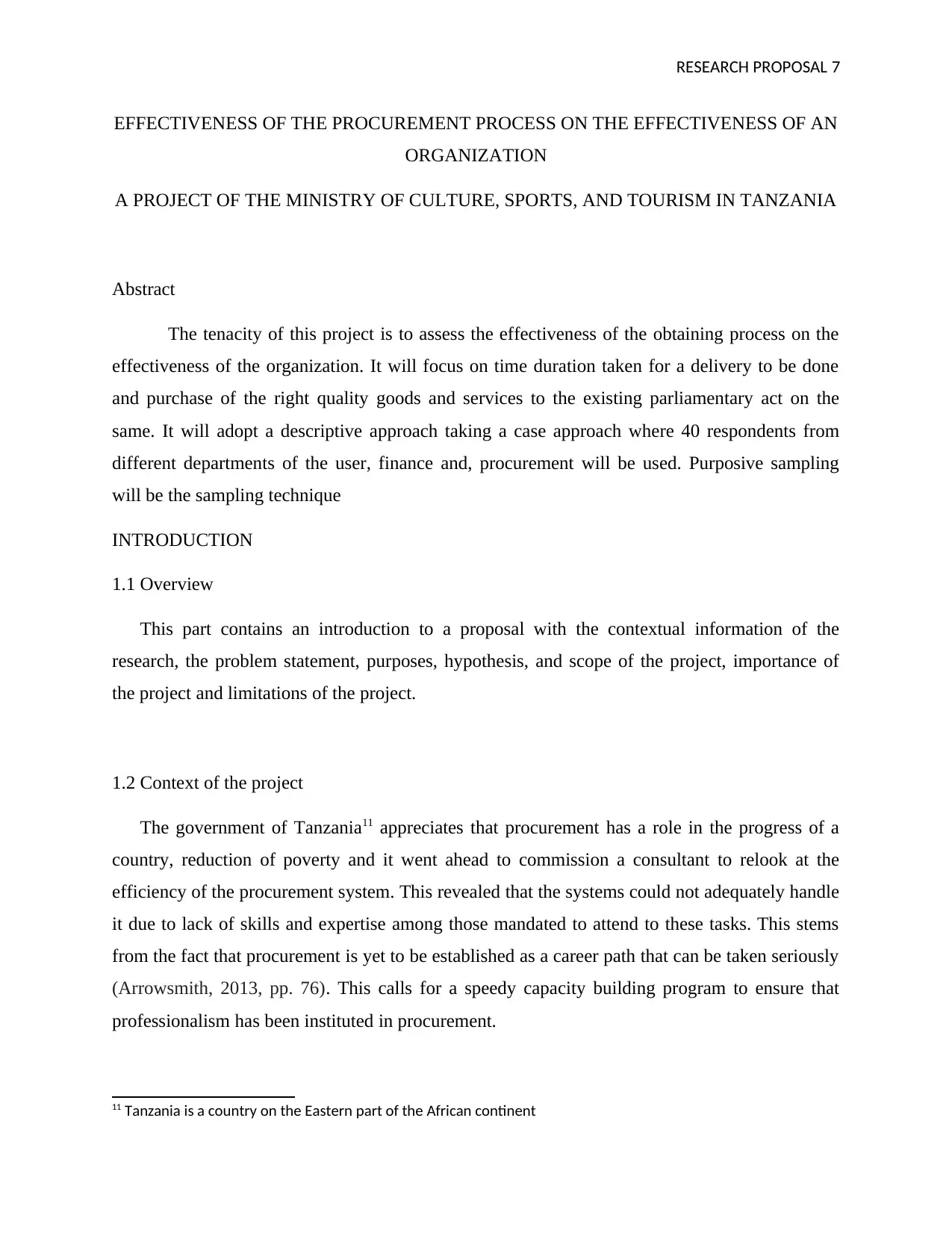
RESEARCH PROPOSAL 7
EFFECTIVENESS OF THE PROCUREMENT PROCESS ON THE EFFECTIVENESS OF AN
ORGANIZATION
A PROJECT OF THE MINISTRY OF CULTURE, SPORTS, AND TOURISM IN TANZANIA
Abstract
The tenacity of this project is to assess the effectiveness of the obtaining process on the
effectiveness of the organization. It will focus on time duration taken for a delivery to be done
and purchase of the right quality goods and services to the existing parliamentary act on the
same. It will adopt a descriptive approach taking a case approach where 40 respondents from
different departments of the user, finance and, procurement will be used. Purposive sampling
will be the sampling technique
INTRODUCTION
1.1 Overview
This part contains an introduction to a proposal with the contextual information of the
research, the problem statement, purposes, hypothesis, and scope of the project, importance of
the project and limitations of the project.
1.2 Context of the project
The government of Tanzania11 appreciates that procurement has a role in the progress of a
country, reduction of poverty and it went ahead to commission a consultant to relook at the
efficiency of the procurement system. This revealed that the systems could not adequately handle
it due to lack of skills and expertise among those mandated to attend to these tasks. This stems
from the fact that procurement is yet to be established as a career path that can be taken seriously
(Arrowsmith, 2013, pp. 76). This calls for a speedy capacity building program to ensure that
professionalism has been instituted in procurement.
11 Tanzania is a country on the Eastern part of the African continent
EFFECTIVENESS OF THE PROCUREMENT PROCESS ON THE EFFECTIVENESS OF AN
ORGANIZATION
A PROJECT OF THE MINISTRY OF CULTURE, SPORTS, AND TOURISM IN TANZANIA
Abstract
The tenacity of this project is to assess the effectiveness of the obtaining process on the
effectiveness of the organization. It will focus on time duration taken for a delivery to be done
and purchase of the right quality goods and services to the existing parliamentary act on the
same. It will adopt a descriptive approach taking a case approach where 40 respondents from
different departments of the user, finance and, procurement will be used. Purposive sampling
will be the sampling technique
INTRODUCTION
1.1 Overview
This part contains an introduction to a proposal with the contextual information of the
research, the problem statement, purposes, hypothesis, and scope of the project, importance of
the project and limitations of the project.
1.2 Context of the project
The government of Tanzania11 appreciates that procurement has a role in the progress of a
country, reduction of poverty and it went ahead to commission a consultant to relook at the
efficiency of the procurement system. This revealed that the systems could not adequately handle
it due to lack of skills and expertise among those mandated to attend to these tasks. This stems
from the fact that procurement is yet to be established as a career path that can be taken seriously
(Arrowsmith, 2013, pp. 76). This calls for a speedy capacity building program to ensure that
professionalism has been instituted in procurement.
11 Tanzania is a country on the Eastern part of the African continent
Paraphrase This Document
Need a fresh take? Get an instant paraphrase of this document with our AI Paraphraser
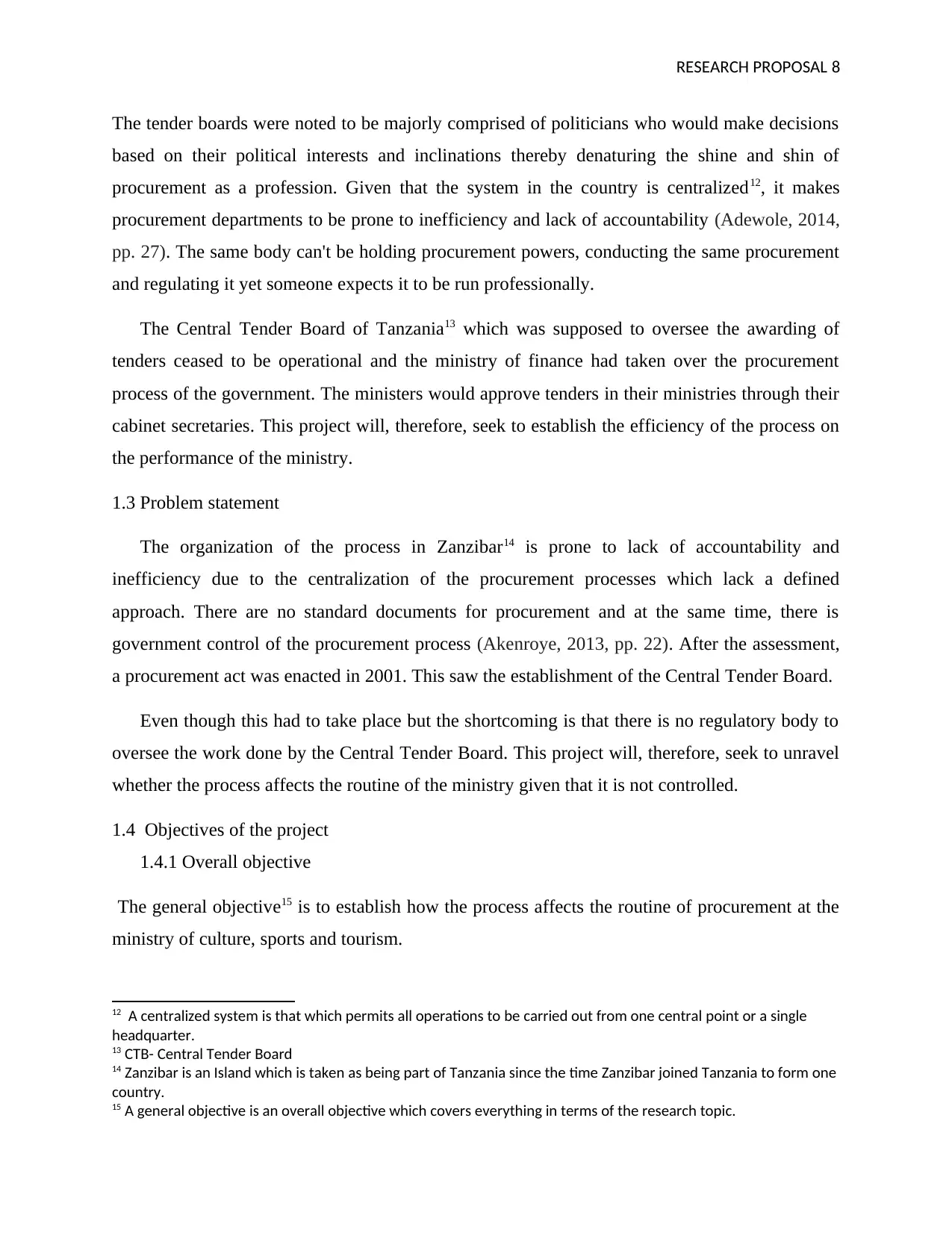
RESEARCH PROPOSAL 8
The tender boards were noted to be majorly comprised of politicians who would make decisions
based on their political interests and inclinations thereby denaturing the shine and shin of
procurement as a profession. Given that the system in the country is centralized12, it makes
procurement departments to be prone to inefficiency and lack of accountability (Adewole, 2014,
pp. 27). The same body can't be holding procurement powers, conducting the same procurement
and regulating it yet someone expects it to be run professionally.
The Central Tender Board of Tanzania13 which was supposed to oversee the awarding of
tenders ceased to be operational and the ministry of finance had taken over the procurement
process of the government. The ministers would approve tenders in their ministries through their
cabinet secretaries. This project will, therefore, seek to establish the efficiency of the process on
the performance of the ministry.
1.3 Problem statement
The organization of the process in Zanzibar14 is prone to lack of accountability and
inefficiency due to the centralization of the procurement processes which lack a defined
approach. There are no standard documents for procurement and at the same time, there is
government control of the procurement process (Akenroye, 2013, pp. 22). After the assessment,
a procurement act was enacted in 2001. This saw the establishment of the Central Tender Board.
Even though this had to take place but the shortcoming is that there is no regulatory body to
oversee the work done by the Central Tender Board. This project will, therefore, seek to unravel
whether the process affects the routine of the ministry given that it is not controlled.
1.4 Objectives of the project
1.4.1 Overall objective
The general objective15 is to establish how the process affects the routine of procurement at the
ministry of culture, sports and tourism.
12 A centralized system is that which permits all operations to be carried out from one central point or a single
headquarter.
13 CTB- Central Tender Board
14 Zanzibar is an Island which is taken as being part of Tanzania since the time Zanzibar joined Tanzania to form one
country.
15 A general objective is an overall objective which covers everything in terms of the research topic.
The tender boards were noted to be majorly comprised of politicians who would make decisions
based on their political interests and inclinations thereby denaturing the shine and shin of
procurement as a profession. Given that the system in the country is centralized12, it makes
procurement departments to be prone to inefficiency and lack of accountability (Adewole, 2014,
pp. 27). The same body can't be holding procurement powers, conducting the same procurement
and regulating it yet someone expects it to be run professionally.
The Central Tender Board of Tanzania13 which was supposed to oversee the awarding of
tenders ceased to be operational and the ministry of finance had taken over the procurement
process of the government. The ministers would approve tenders in their ministries through their
cabinet secretaries. This project will, therefore, seek to establish the efficiency of the process on
the performance of the ministry.
1.3 Problem statement
The organization of the process in Zanzibar14 is prone to lack of accountability and
inefficiency due to the centralization of the procurement processes which lack a defined
approach. There are no standard documents for procurement and at the same time, there is
government control of the procurement process (Akenroye, 2013, pp. 22). After the assessment,
a procurement act was enacted in 2001. This saw the establishment of the Central Tender Board.
Even though this had to take place but the shortcoming is that there is no regulatory body to
oversee the work done by the Central Tender Board. This project will, therefore, seek to unravel
whether the process affects the routine of the ministry given that it is not controlled.
1.4 Objectives of the project
1.4.1 Overall objective
The general objective15 is to establish how the process affects the routine of procurement at the
ministry of culture, sports and tourism.
12 A centralized system is that which permits all operations to be carried out from one central point or a single
headquarter.
13 CTB- Central Tender Board
14 Zanzibar is an Island which is taken as being part of Tanzania since the time Zanzibar joined Tanzania to form one
country.
15 A general objective is an overall objective which covers everything in terms of the research topic.
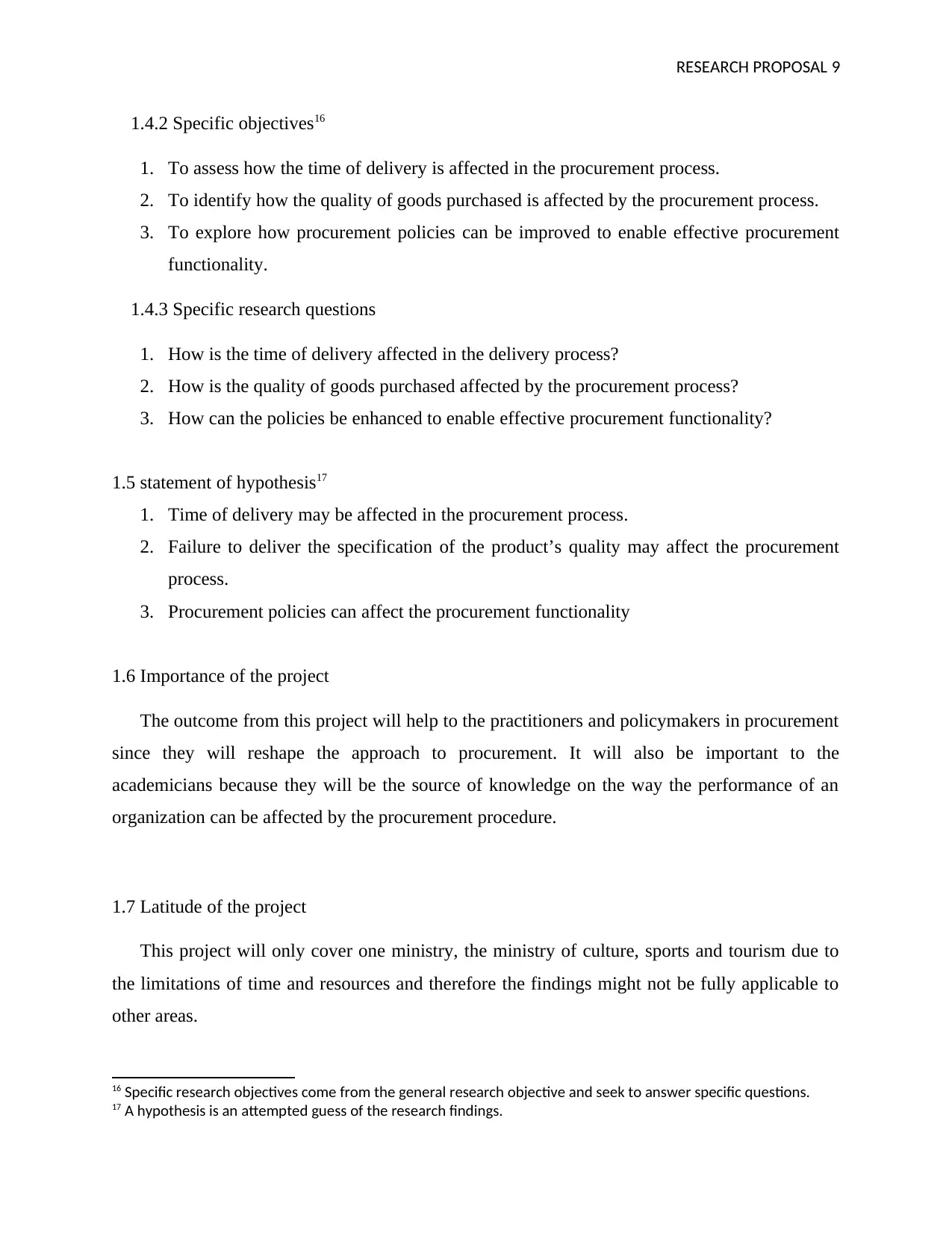
RESEARCH PROPOSAL 9
1.4.2 Specific objectives16
1. To assess how the time of delivery is affected in the procurement process.
2. To identify how the quality of goods purchased is affected by the procurement process.
3. To explore how procurement policies can be improved to enable effective procurement
functionality.
1.4.3 Specific research questions
1. How is the time of delivery affected in the delivery process?
2. How is the quality of goods purchased affected by the procurement process?
3. How can the policies be enhanced to enable effective procurement functionality?
1.5 statement of hypothesis17
1. Time of delivery may be affected in the procurement process.
2. Failure to deliver the specification of the product’s quality may affect the procurement
process.
3. Procurement policies can affect the procurement functionality
1.6 Importance of the project
The outcome from this project will help to the practitioners and policymakers in procurement
since they will reshape the approach to procurement. It will also be important to the
academicians because they will be the source of knowledge on the way the performance of an
organization can be affected by the procurement procedure.
1.7 Latitude of the project
This project will only cover one ministry, the ministry of culture, sports and tourism due to
the limitations of time and resources and therefore the findings might not be fully applicable to
other areas.
16 Specific research objectives come from the general research objective and seek to answer specific questions.
17 A hypothesis is an attempted guess of the research findings.
1.4.2 Specific objectives16
1. To assess how the time of delivery is affected in the procurement process.
2. To identify how the quality of goods purchased is affected by the procurement process.
3. To explore how procurement policies can be improved to enable effective procurement
functionality.
1.4.3 Specific research questions
1. How is the time of delivery affected in the delivery process?
2. How is the quality of goods purchased affected by the procurement process?
3. How can the policies be enhanced to enable effective procurement functionality?
1.5 statement of hypothesis17
1. Time of delivery may be affected in the procurement process.
2. Failure to deliver the specification of the product’s quality may affect the procurement
process.
3. Procurement policies can affect the procurement functionality
1.6 Importance of the project
The outcome from this project will help to the practitioners and policymakers in procurement
since they will reshape the approach to procurement. It will also be important to the
academicians because they will be the source of knowledge on the way the performance of an
organization can be affected by the procurement procedure.
1.7 Latitude of the project
This project will only cover one ministry, the ministry of culture, sports and tourism due to
the limitations of time and resources and therefore the findings might not be fully applicable to
other areas.
16 Specific research objectives come from the general research objective and seek to answer specific questions.
17 A hypothesis is an attempted guess of the research findings.
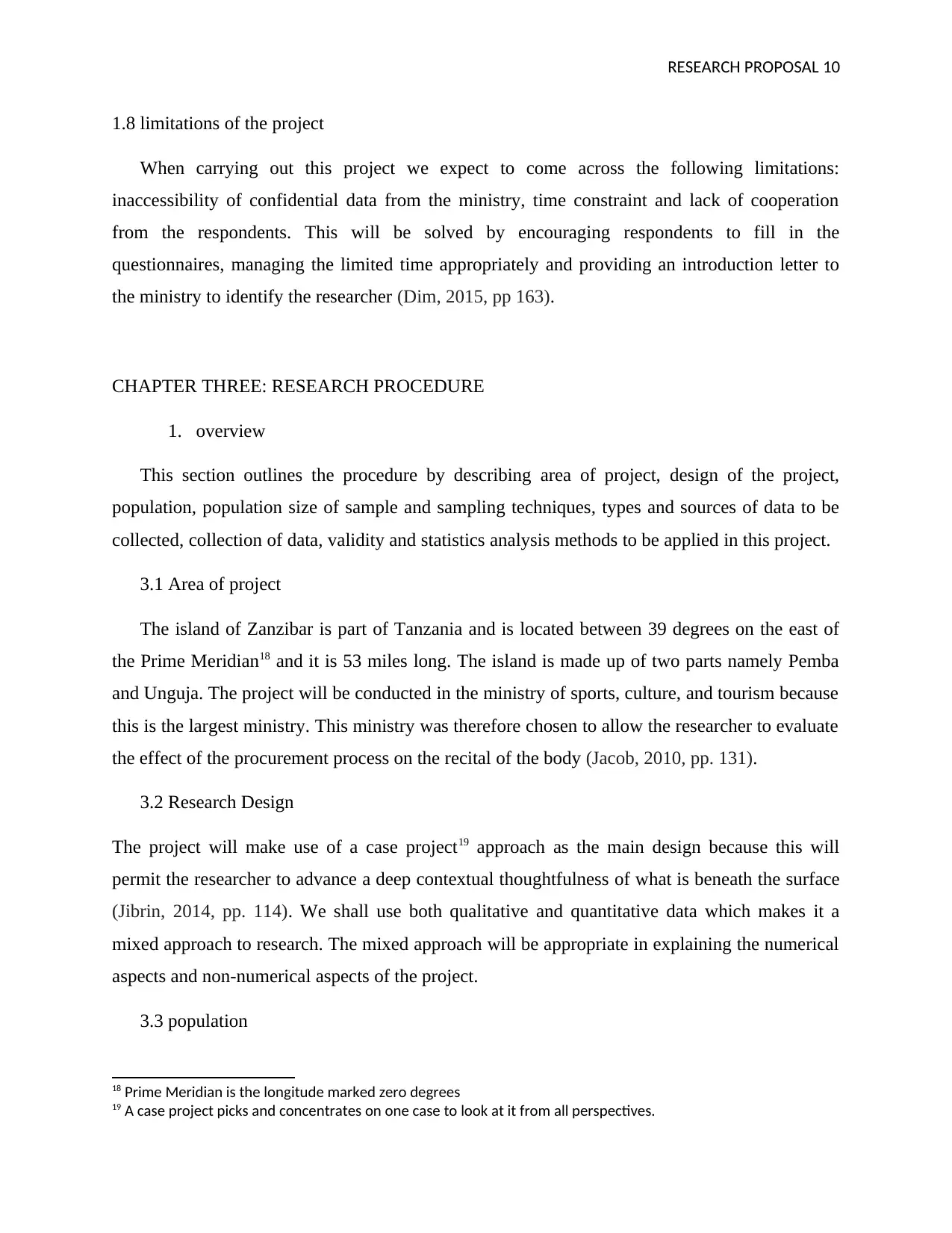
RESEARCH PROPOSAL 10
1.8 limitations of the project
When carrying out this project we expect to come across the following limitations:
inaccessibility of confidential data from the ministry, time constraint and lack of cooperation
from the respondents. This will be solved by encouraging respondents to fill in the
questionnaires, managing the limited time appropriately and providing an introduction letter to
the ministry to identify the researcher (Dim, 2015, pp 163).
CHAPTER THREE: RESEARCH PROCEDURE
1. overview
This section outlines the procedure by describing area of project, design of the project,
population, population size of sample and sampling techniques, types and sources of data to be
collected, collection of data, validity and statistics analysis methods to be applied in this project.
3.1 Area of project
The island of Zanzibar is part of Tanzania and is located between 39 degrees on the east of
the Prime Meridian18 and it is 53 miles long. The island is made up of two parts namely Pemba
and Unguja. The project will be conducted in the ministry of sports, culture, and tourism because
this is the largest ministry. This ministry was therefore chosen to allow the researcher to evaluate
the effect of the procurement process on the recital of the body (Jacob, 2010, pp. 131).
3.2 Research Design
The project will make use of a case project19 approach as the main design because this will
permit the researcher to advance a deep contextual thoughtfulness of what is beneath the surface
(Jibrin, 2014, pp. 114). We shall use both qualitative and quantitative data which makes it a
mixed approach to research. The mixed approach will be appropriate in explaining the numerical
aspects and non-numerical aspects of the project.
3.3 population
18 Prime Meridian is the longitude marked zero degrees
19 A case project picks and concentrates on one case to look at it from all perspectives.
1.8 limitations of the project
When carrying out this project we expect to come across the following limitations:
inaccessibility of confidential data from the ministry, time constraint and lack of cooperation
from the respondents. This will be solved by encouraging respondents to fill in the
questionnaires, managing the limited time appropriately and providing an introduction letter to
the ministry to identify the researcher (Dim, 2015, pp 163).
CHAPTER THREE: RESEARCH PROCEDURE
1. overview
This section outlines the procedure by describing area of project, design of the project,
population, population size of sample and sampling techniques, types and sources of data to be
collected, collection of data, validity and statistics analysis methods to be applied in this project.
3.1 Area of project
The island of Zanzibar is part of Tanzania and is located between 39 degrees on the east of
the Prime Meridian18 and it is 53 miles long. The island is made up of two parts namely Pemba
and Unguja. The project will be conducted in the ministry of sports, culture, and tourism because
this is the largest ministry. This ministry was therefore chosen to allow the researcher to evaluate
the effect of the procurement process on the recital of the body (Jacob, 2010, pp. 131).
3.2 Research Design
The project will make use of a case project19 approach as the main design because this will
permit the researcher to advance a deep contextual thoughtfulness of what is beneath the surface
(Jibrin, 2014, pp. 114). We shall use both qualitative and quantitative data which makes it a
mixed approach to research. The mixed approach will be appropriate in explaining the numerical
aspects and non-numerical aspects of the project.
3.3 population
18 Prime Meridian is the longitude marked zero degrees
19 A case project picks and concentrates on one case to look at it from all perspectives.
Secure Best Marks with AI Grader
Need help grading? Try our AI Grader for instant feedback on your assignments.
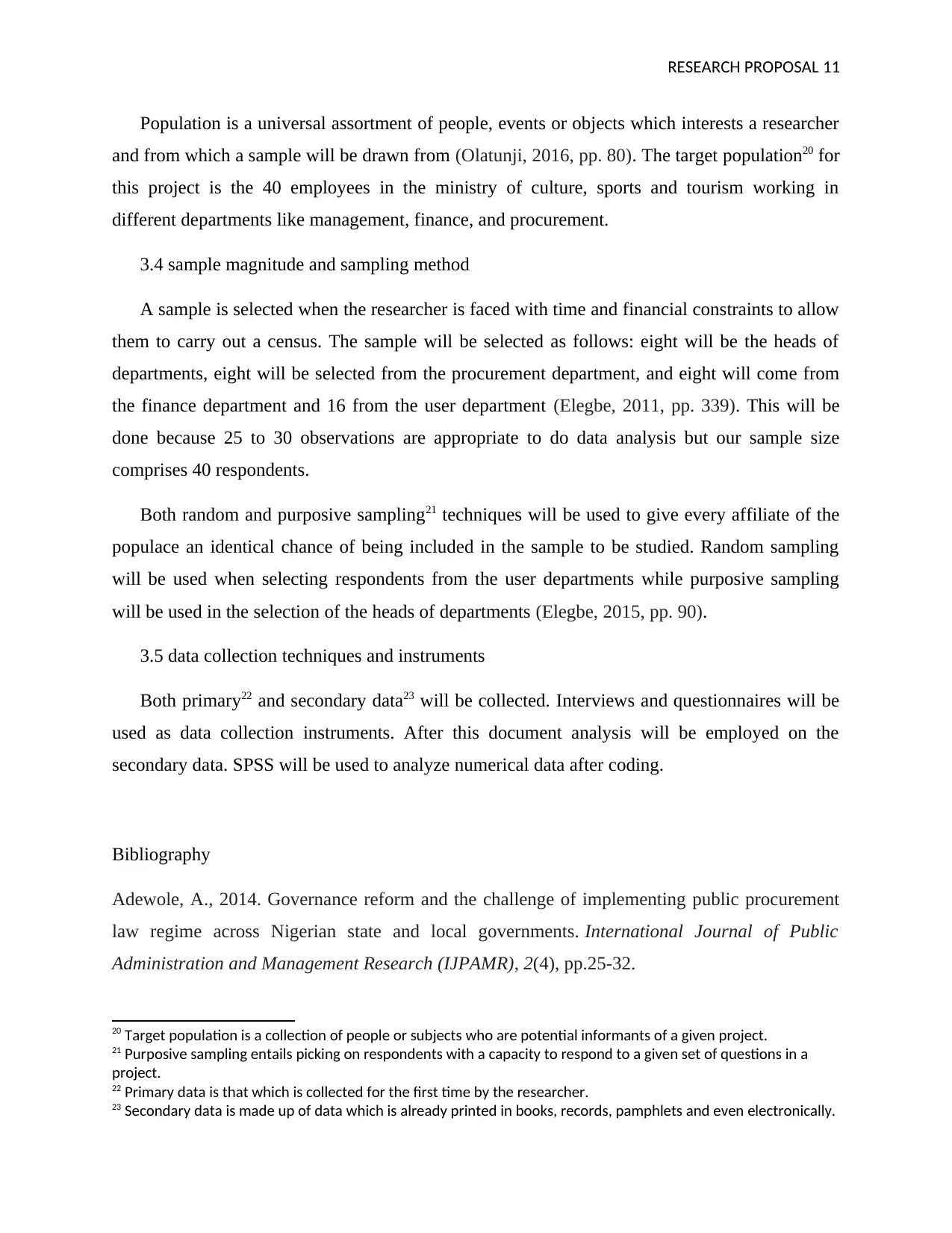
RESEARCH PROPOSAL 11
Population is a universal assortment of people, events or objects which interests a researcher
and from which a sample will be drawn from (Olatunji, 2016, pp. 80). The target population20 for
this project is the 40 employees in the ministry of culture, sports and tourism working in
different departments like management, finance, and procurement.
3.4 sample magnitude and sampling method
A sample is selected when the researcher is faced with time and financial constraints to allow
them to carry out a census. The sample will be selected as follows: eight will be the heads of
departments, eight will be selected from the procurement department, and eight will come from
the finance department and 16 from the user department (Elegbe, 2011, pp. 339). This will be
done because 25 to 30 observations are appropriate to do data analysis but our sample size
comprises 40 respondents.
Both random and purposive sampling21 techniques will be used to give every affiliate of the
populace an identical chance of being included in the sample to be studied. Random sampling
will be used when selecting respondents from the user departments while purposive sampling
will be used in the selection of the heads of departments (Elegbe, 2015, pp. 90).
3.5 data collection techniques and instruments
Both primary22 and secondary data23 will be collected. Interviews and questionnaires will be
used as data collection instruments. After this document analysis will be employed on the
secondary data. SPSS will be used to analyze numerical data after coding.
Bibliography
Adewole, A., 2014. Governance reform and the challenge of implementing public procurement
law regime across Nigerian state and local governments. International Journal of Public
Administration and Management Research (IJPAMR), 2(4), pp.25-32.
20 Target population is a collection of people or subjects who are potential informants of a given project.
21 Purposive sampling entails picking on respondents with a capacity to respond to a given set of questions in a
project.
22 Primary data is that which is collected for the first time by the researcher.
23 Secondary data is made up of data which is already printed in books, records, pamphlets and even electronically.
Population is a universal assortment of people, events or objects which interests a researcher
and from which a sample will be drawn from (Olatunji, 2016, pp. 80). The target population20 for
this project is the 40 employees in the ministry of culture, sports and tourism working in
different departments like management, finance, and procurement.
3.4 sample magnitude and sampling method
A sample is selected when the researcher is faced with time and financial constraints to allow
them to carry out a census. The sample will be selected as follows: eight will be the heads of
departments, eight will be selected from the procurement department, and eight will come from
the finance department and 16 from the user department (Elegbe, 2011, pp. 339). This will be
done because 25 to 30 observations are appropriate to do data analysis but our sample size
comprises 40 respondents.
Both random and purposive sampling21 techniques will be used to give every affiliate of the
populace an identical chance of being included in the sample to be studied. Random sampling
will be used when selecting respondents from the user departments while purposive sampling
will be used in the selection of the heads of departments (Elegbe, 2015, pp. 90).
3.5 data collection techniques and instruments
Both primary22 and secondary data23 will be collected. Interviews and questionnaires will be
used as data collection instruments. After this document analysis will be employed on the
secondary data. SPSS will be used to analyze numerical data after coding.
Bibliography
Adewole, A., 2014. Governance reform and the challenge of implementing public procurement
law regime across Nigerian state and local governments. International Journal of Public
Administration and Management Research (IJPAMR), 2(4), pp.25-32.
20 Target population is a collection of people or subjects who are potential informants of a given project.
21 Purposive sampling entails picking on respondents with a capacity to respond to a given set of questions in a
project.
22 Primary data is that which is collected for the first time by the researcher.
23 Secondary data is made up of data which is already printed in books, records, pamphlets and even electronically.
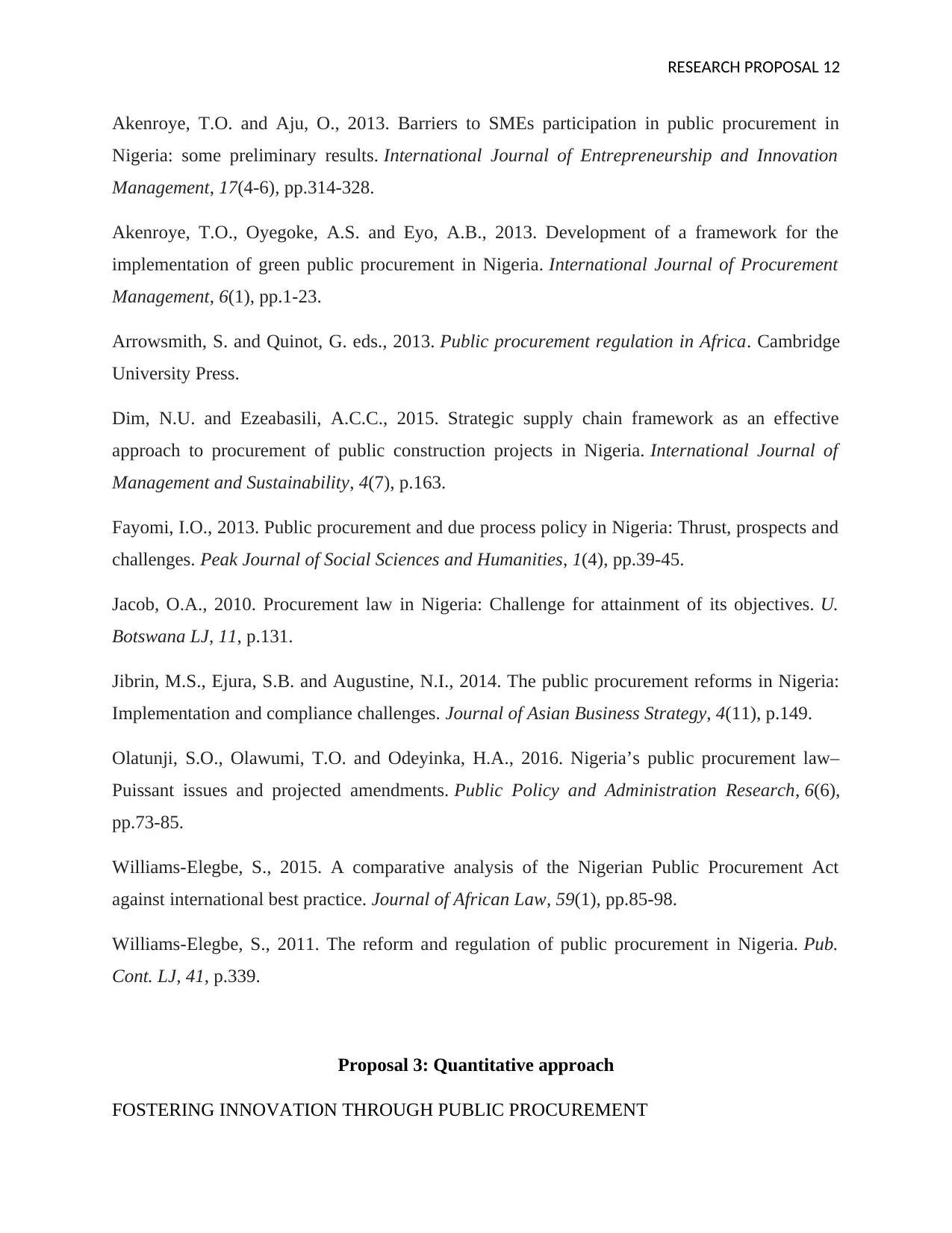
RESEARCH PROPOSAL 12
Akenroye, T.O. and Aju, O., 2013. Barriers to SMEs participation in public procurement in
Nigeria: some preliminary results. International Journal of Entrepreneurship and Innovation
Management, 17(4-6), pp.314-328.
Akenroye, T.O., Oyegoke, A.S. and Eyo, A.B., 2013. Development of a framework for the
implementation of green public procurement in Nigeria. International Journal of Procurement
Management, 6(1), pp.1-23.
Arrowsmith, S. and Quinot, G. eds., 2013. Public procurement regulation in Africa. Cambridge
University Press.
Dim, N.U. and Ezeabasili, A.C.C., 2015. Strategic supply chain framework as an effective
approach to procurement of public construction projects in Nigeria. International Journal of
Management and Sustainability, 4(7), p.163.
Fayomi, I.O., 2013. Public procurement and due process policy in Nigeria: Thrust, prospects and
challenges. Peak Journal of Social Sciences and Humanities, 1(4), pp.39-45.
Jacob, O.A., 2010. Procurement law in Nigeria: Challenge for attainment of its objectives. U.
Botswana LJ, 11, p.131.
Jibrin, M.S., Ejura, S.B. and Augustine, N.I., 2014. The public procurement reforms in Nigeria:
Implementation and compliance challenges. Journal of Asian Business Strategy, 4(11), p.149.
Olatunji, S.O., Olawumi, T.O. and Odeyinka, H.A., 2016. Nigeria’s public procurement law–
Puissant issues and projected amendments. Public Policy and Administration Research, 6(6),
pp.73-85.
Williams-Elegbe, S., 2015. A comparative analysis of the Nigerian Public Procurement Act
against international best practice. Journal of African Law, 59(1), pp.85-98.
Williams-Elegbe, S., 2011. The reform and regulation of public procurement in Nigeria. Pub.
Cont. LJ, 41, p.339.
Proposal 3: Quantitative approach
FOSTERING INNOVATION THROUGH PUBLIC PROCUREMENT
Akenroye, T.O. and Aju, O., 2013. Barriers to SMEs participation in public procurement in
Nigeria: some preliminary results. International Journal of Entrepreneurship and Innovation
Management, 17(4-6), pp.314-328.
Akenroye, T.O., Oyegoke, A.S. and Eyo, A.B., 2013. Development of a framework for the
implementation of green public procurement in Nigeria. International Journal of Procurement
Management, 6(1), pp.1-23.
Arrowsmith, S. and Quinot, G. eds., 2013. Public procurement regulation in Africa. Cambridge
University Press.
Dim, N.U. and Ezeabasili, A.C.C., 2015. Strategic supply chain framework as an effective
approach to procurement of public construction projects in Nigeria. International Journal of
Management and Sustainability, 4(7), p.163.
Fayomi, I.O., 2013. Public procurement and due process policy in Nigeria: Thrust, prospects and
challenges. Peak Journal of Social Sciences and Humanities, 1(4), pp.39-45.
Jacob, O.A., 2010. Procurement law in Nigeria: Challenge for attainment of its objectives. U.
Botswana LJ, 11, p.131.
Jibrin, M.S., Ejura, S.B. and Augustine, N.I., 2014. The public procurement reforms in Nigeria:
Implementation and compliance challenges. Journal of Asian Business Strategy, 4(11), p.149.
Olatunji, S.O., Olawumi, T.O. and Odeyinka, H.A., 2016. Nigeria’s public procurement law–
Puissant issues and projected amendments. Public Policy and Administration Research, 6(6),
pp.73-85.
Williams-Elegbe, S., 2015. A comparative analysis of the Nigerian Public Procurement Act
against international best practice. Journal of African Law, 59(1), pp.85-98.
Williams-Elegbe, S., 2011. The reform and regulation of public procurement in Nigeria. Pub.
Cont. LJ, 41, p.339.
Proposal 3: Quantitative approach
FOSTERING INNOVATION THROUGH PUBLIC PROCUREMENT
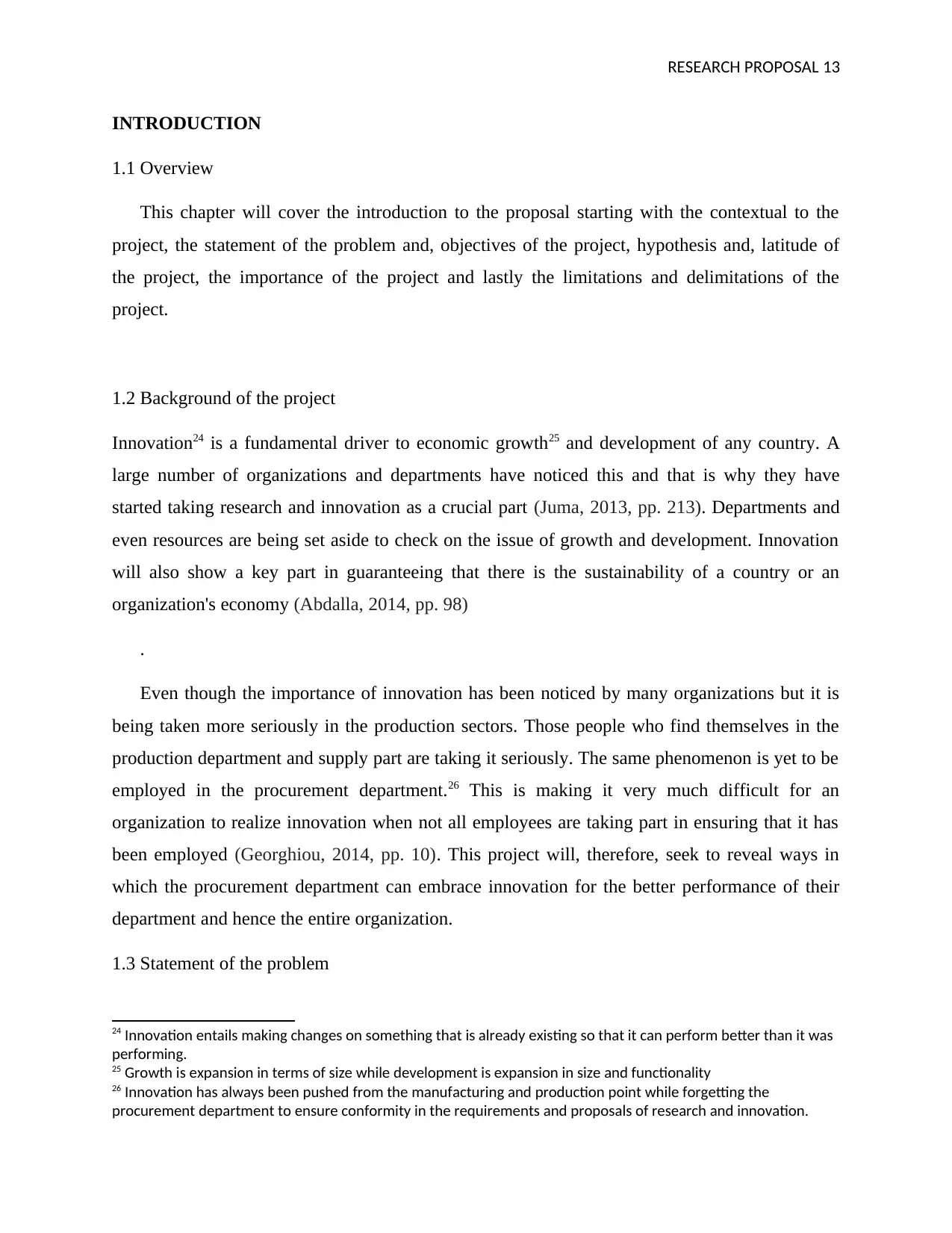
RESEARCH PROPOSAL 13
INTRODUCTION
1.1 Overview
This chapter will cover the introduction to the proposal starting with the contextual to the
project, the statement of the problem and, objectives of the project, hypothesis and, latitude of
the project, the importance of the project and lastly the limitations and delimitations of the
project.
1.2 Background of the project
Innovation24 is a fundamental driver to economic growth25 and development of any country. A
large number of organizations and departments have noticed this and that is why they have
started taking research and innovation as a crucial part (Juma, 2013, pp. 213). Departments and
even resources are being set aside to check on the issue of growth and development. Innovation
will also show a key part in guaranteeing that there is the sustainability of a country or an
organization's economy (Abdalla, 2014, pp. 98)
.
Even though the importance of innovation has been noticed by many organizations but it is
being taken more seriously in the production sectors. Those people who find themselves in the
production department and supply part are taking it seriously. The same phenomenon is yet to be
employed in the procurement department.26 This is making it very much difficult for an
organization to realize innovation when not all employees are taking part in ensuring that it has
been employed (Georghiou, 2014, pp. 10). This project will, therefore, seek to reveal ways in
which the procurement department can embrace innovation for the better performance of their
department and hence the entire organization.
1.3 Statement of the problem
24 Innovation entails making changes on something that is already existing so that it can perform better than it was
performing.
25 Growth is expansion in terms of size while development is expansion in size and functionality
26 Innovation has always been pushed from the manufacturing and production point while forgetting the
procurement department to ensure conformity in the requirements and proposals of research and innovation.
INTRODUCTION
1.1 Overview
This chapter will cover the introduction to the proposal starting with the contextual to the
project, the statement of the problem and, objectives of the project, hypothesis and, latitude of
the project, the importance of the project and lastly the limitations and delimitations of the
project.
1.2 Background of the project
Innovation24 is a fundamental driver to economic growth25 and development of any country. A
large number of organizations and departments have noticed this and that is why they have
started taking research and innovation as a crucial part (Juma, 2013, pp. 213). Departments and
even resources are being set aside to check on the issue of growth and development. Innovation
will also show a key part in guaranteeing that there is the sustainability of a country or an
organization's economy (Abdalla, 2014, pp. 98)
.
Even though the importance of innovation has been noticed by many organizations but it is
being taken more seriously in the production sectors. Those people who find themselves in the
production department and supply part are taking it seriously. The same phenomenon is yet to be
employed in the procurement department.26 This is making it very much difficult for an
organization to realize innovation when not all employees are taking part in ensuring that it has
been employed (Georghiou, 2014, pp. 10). This project will, therefore, seek to reveal ways in
which the procurement department can embrace innovation for the better performance of their
department and hence the entire organization.
1.3 Statement of the problem
24 Innovation entails making changes on something that is already existing so that it can perform better than it was
performing.
25 Growth is expansion in terms of size while development is expansion in size and functionality
26 Innovation has always been pushed from the manufacturing and production point while forgetting the
procurement department to ensure conformity in the requirements and proposals of research and innovation.
Paraphrase This Document
Need a fresh take? Get an instant paraphrase of this document with our AI Paraphraser
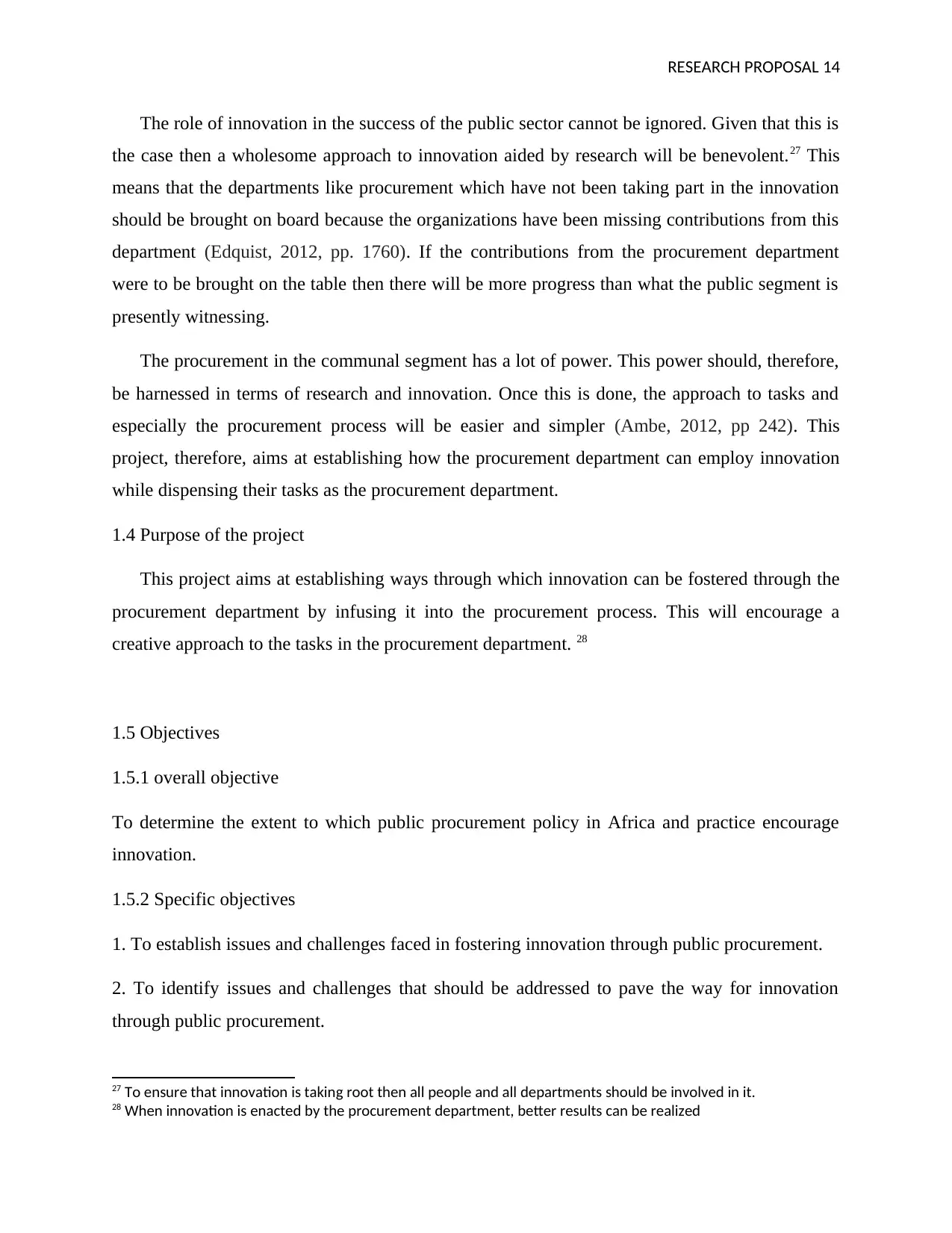
RESEARCH PROPOSAL 14
The role of innovation in the success of the public sector cannot be ignored. Given that this is
the case then a wholesome approach to innovation aided by research will be benevolent.27 This
means that the departments like procurement which have not been taking part in the innovation
should be brought on board because the organizations have been missing contributions from this
department (Edquist, 2012, pp. 1760). If the contributions from the procurement department
were to be brought on the table then there will be more progress than what the public segment is
presently witnessing.
The procurement in the communal segment has a lot of power. This power should, therefore,
be harnessed in terms of research and innovation. Once this is done, the approach to tasks and
especially the procurement process will be easier and simpler (Ambe, 2012, pp 242). This
project, therefore, aims at establishing how the procurement department can employ innovation
while dispensing their tasks as the procurement department.
1.4 Purpose of the project
This project aims at establishing ways through which innovation can be fostered through the
procurement department by infusing it into the procurement process. This will encourage a
creative approach to the tasks in the procurement department. 28
1.5 Objectives
1.5.1 overall objective
To determine the extent to which public procurement policy in Africa and practice encourage
innovation.
1.5.2 Specific objectives
1. To establish issues and challenges faced in fostering innovation through public procurement.
2. To identify issues and challenges that should be addressed to pave the way for innovation
through public procurement.
27 To ensure that innovation is taking root then all people and all departments should be involved in it.
28 When innovation is enacted by the procurement department, better results can be realized
The role of innovation in the success of the public sector cannot be ignored. Given that this is
the case then a wholesome approach to innovation aided by research will be benevolent.27 This
means that the departments like procurement which have not been taking part in the innovation
should be brought on board because the organizations have been missing contributions from this
department (Edquist, 2012, pp. 1760). If the contributions from the procurement department
were to be brought on the table then there will be more progress than what the public segment is
presently witnessing.
The procurement in the communal segment has a lot of power. This power should, therefore,
be harnessed in terms of research and innovation. Once this is done, the approach to tasks and
especially the procurement process will be easier and simpler (Ambe, 2012, pp 242). This
project, therefore, aims at establishing how the procurement department can employ innovation
while dispensing their tasks as the procurement department.
1.4 Purpose of the project
This project aims at establishing ways through which innovation can be fostered through the
procurement department by infusing it into the procurement process. This will encourage a
creative approach to the tasks in the procurement department. 28
1.5 Objectives
1.5.1 overall objective
To determine the extent to which public procurement policy in Africa and practice encourage
innovation.
1.5.2 Specific objectives
1. To establish issues and challenges faced in fostering innovation through public procurement.
2. To identify issues and challenges that should be addressed to pave the way for innovation
through public procurement.
27 To ensure that innovation is taking root then all people and all departments should be involved in it.
28 When innovation is enacted by the procurement department, better results can be realized
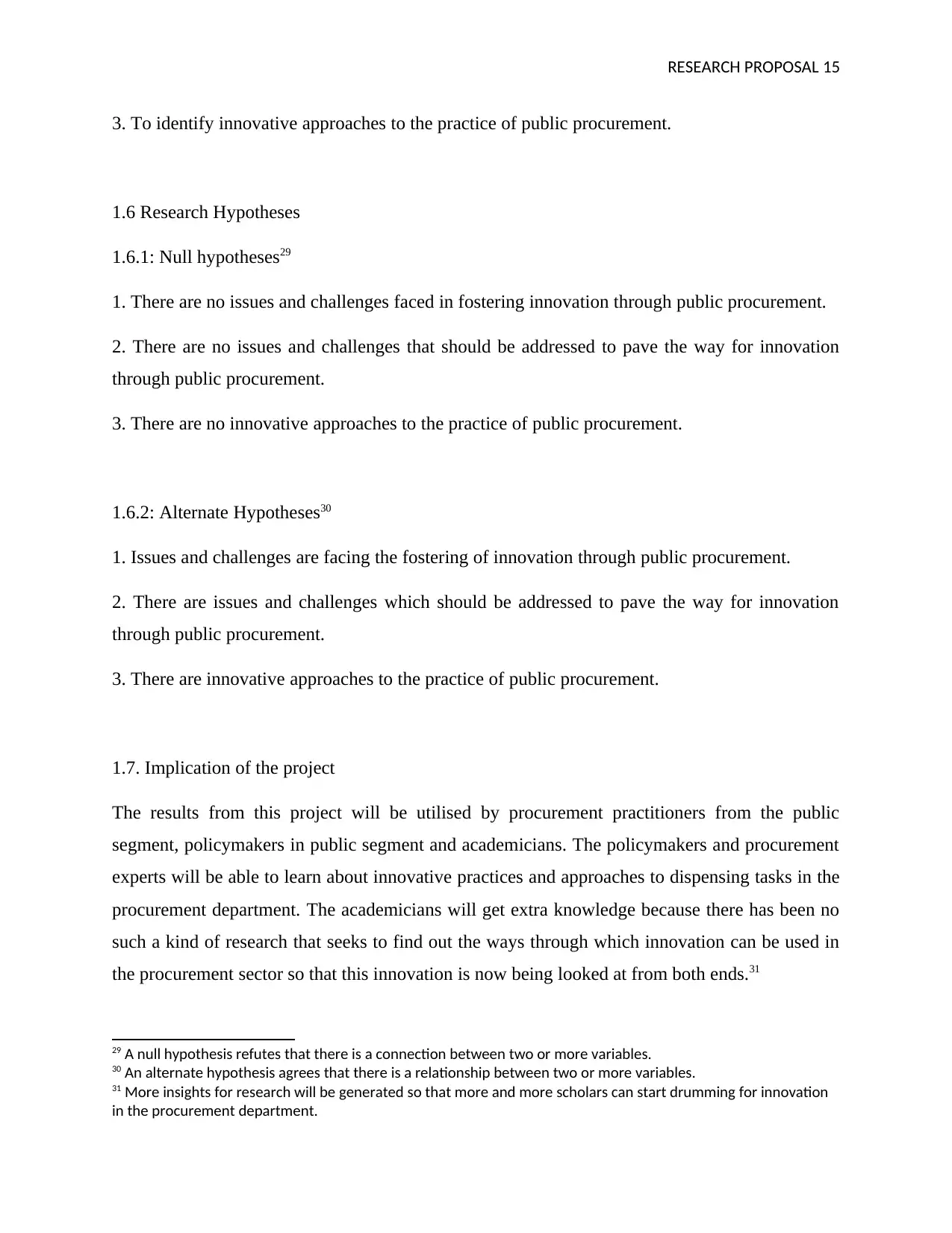
RESEARCH PROPOSAL 15
3. To identify innovative approaches to the practice of public procurement.
1.6 Research Hypotheses
1.6.1: Null hypotheses29
1. There are no issues and challenges faced in fostering innovation through public procurement.
2. There are no issues and challenges that should be addressed to pave the way for innovation
through public procurement.
3. There are no innovative approaches to the practice of public procurement.
1.6.2: Alternate Hypotheses30
1. Issues and challenges are facing the fostering of innovation through public procurement.
2. There are issues and challenges which should be addressed to pave the way for innovation
through public procurement.
3. There are innovative approaches to the practice of public procurement.
1.7. Implication of the project
The results from this project will be utilised by procurement practitioners from the public
segment, policymakers in public segment and academicians. The policymakers and procurement
experts will be able to learn about innovative practices and approaches to dispensing tasks in the
procurement department. The academicians will get extra knowledge because there has been no
such a kind of research that seeks to find out the ways through which innovation can be used in
the procurement sector so that this innovation is now being looked at from both ends.31
29 A null hypothesis refutes that there is a connection between two or more variables.
30 An alternate hypothesis agrees that there is a relationship between two or more variables.
31 More insights for research will be generated so that more and more scholars can start drumming for innovation
in the procurement department.
3. To identify innovative approaches to the practice of public procurement.
1.6 Research Hypotheses
1.6.1: Null hypotheses29
1. There are no issues and challenges faced in fostering innovation through public procurement.
2. There are no issues and challenges that should be addressed to pave the way for innovation
through public procurement.
3. There are no innovative approaches to the practice of public procurement.
1.6.2: Alternate Hypotheses30
1. Issues and challenges are facing the fostering of innovation through public procurement.
2. There are issues and challenges which should be addressed to pave the way for innovation
through public procurement.
3. There are innovative approaches to the practice of public procurement.
1.7. Implication of the project
The results from this project will be utilised by procurement practitioners from the public
segment, policymakers in public segment and academicians. The policymakers and procurement
experts will be able to learn about innovative practices and approaches to dispensing tasks in the
procurement department. The academicians will get extra knowledge because there has been no
such a kind of research that seeks to find out the ways through which innovation can be used in
the procurement sector so that this innovation is now being looked at from both ends.31
29 A null hypothesis refutes that there is a connection between two or more variables.
30 An alternate hypothesis agrees that there is a relationship between two or more variables.
31 More insights for research will be generated so that more and more scholars can start drumming for innovation
in the procurement department.
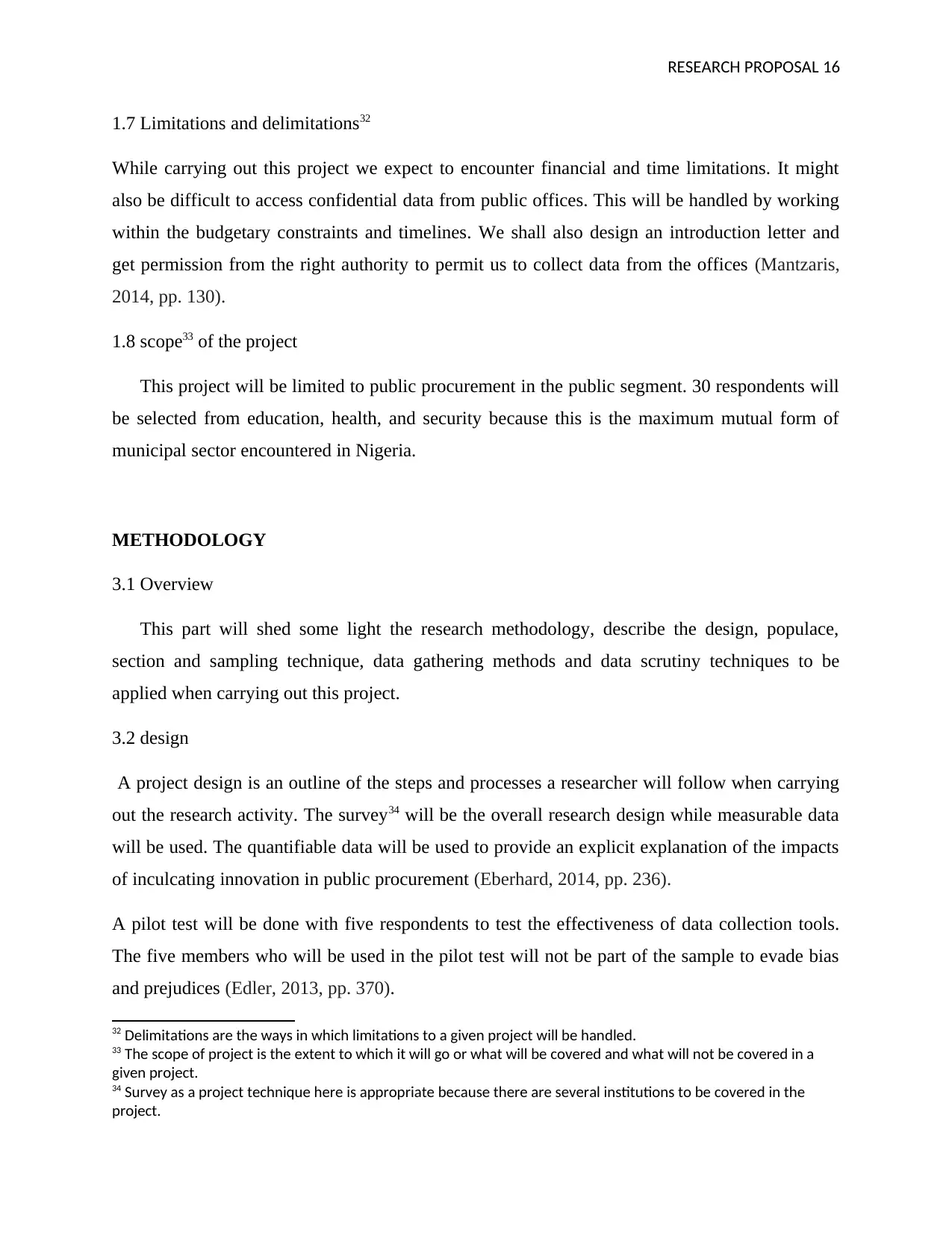
RESEARCH PROPOSAL 16
1.7 Limitations and delimitations32
While carrying out this project we expect to encounter financial and time limitations. It might
also be difficult to access confidential data from public offices. This will be handled by working
within the budgetary constraints and timelines. We shall also design an introduction letter and
get permission from the right authority to permit us to collect data from the offices (Mantzaris,
2014, pp. 130).
1.8 scope33 of the project
This project will be limited to public procurement in the public segment. 30 respondents will
be selected from education, health, and security because this is the maximum mutual form of
municipal sector encountered in Nigeria.
METHODOLOGY
3.1 Overview
This part will shed some light the research methodology, describe the design, populace,
section and sampling technique, data gathering methods and data scrutiny techniques to be
applied when carrying out this project.
3.2 design
A project design is an outline of the steps and processes a researcher will follow when carrying
out the research activity. The survey34 will be the overall research design while measurable data
will be used. The quantifiable data will be used to provide an explicit explanation of the impacts
of inculcating innovation in public procurement (Eberhard, 2014, pp. 236).
A pilot test will be done with five respondents to test the effectiveness of data collection tools.
The five members who will be used in the pilot test will not be part of the sample to evade bias
and prejudices (Edler, 2013, pp. 370).
32 Delimitations are the ways in which limitations to a given project will be handled.
33 The scope of project is the extent to which it will go or what will be covered and what will not be covered in a
given project.
34 Survey as a project technique here is appropriate because there are several institutions to be covered in the
project.
1.7 Limitations and delimitations32
While carrying out this project we expect to encounter financial and time limitations. It might
also be difficult to access confidential data from public offices. This will be handled by working
within the budgetary constraints and timelines. We shall also design an introduction letter and
get permission from the right authority to permit us to collect data from the offices (Mantzaris,
2014, pp. 130).
1.8 scope33 of the project
This project will be limited to public procurement in the public segment. 30 respondents will
be selected from education, health, and security because this is the maximum mutual form of
municipal sector encountered in Nigeria.
METHODOLOGY
3.1 Overview
This part will shed some light the research methodology, describe the design, populace,
section and sampling technique, data gathering methods and data scrutiny techniques to be
applied when carrying out this project.
3.2 design
A project design is an outline of the steps and processes a researcher will follow when carrying
out the research activity. The survey34 will be the overall research design while measurable data
will be used. The quantifiable data will be used to provide an explicit explanation of the impacts
of inculcating innovation in public procurement (Eberhard, 2014, pp. 236).
A pilot test will be done with five respondents to test the effectiveness of data collection tools.
The five members who will be used in the pilot test will not be part of the sample to evade bias
and prejudices (Edler, 2013, pp. 370).
32 Delimitations are the ways in which limitations to a given project will be handled.
33 The scope of project is the extent to which it will go or what will be covered and what will not be covered in a
given project.
34 Survey as a project technique here is appropriate because there are several institutions to be covered in the
project.
Secure Best Marks with AI Grader
Need help grading? Try our AI Grader for instant feedback on your assignments.
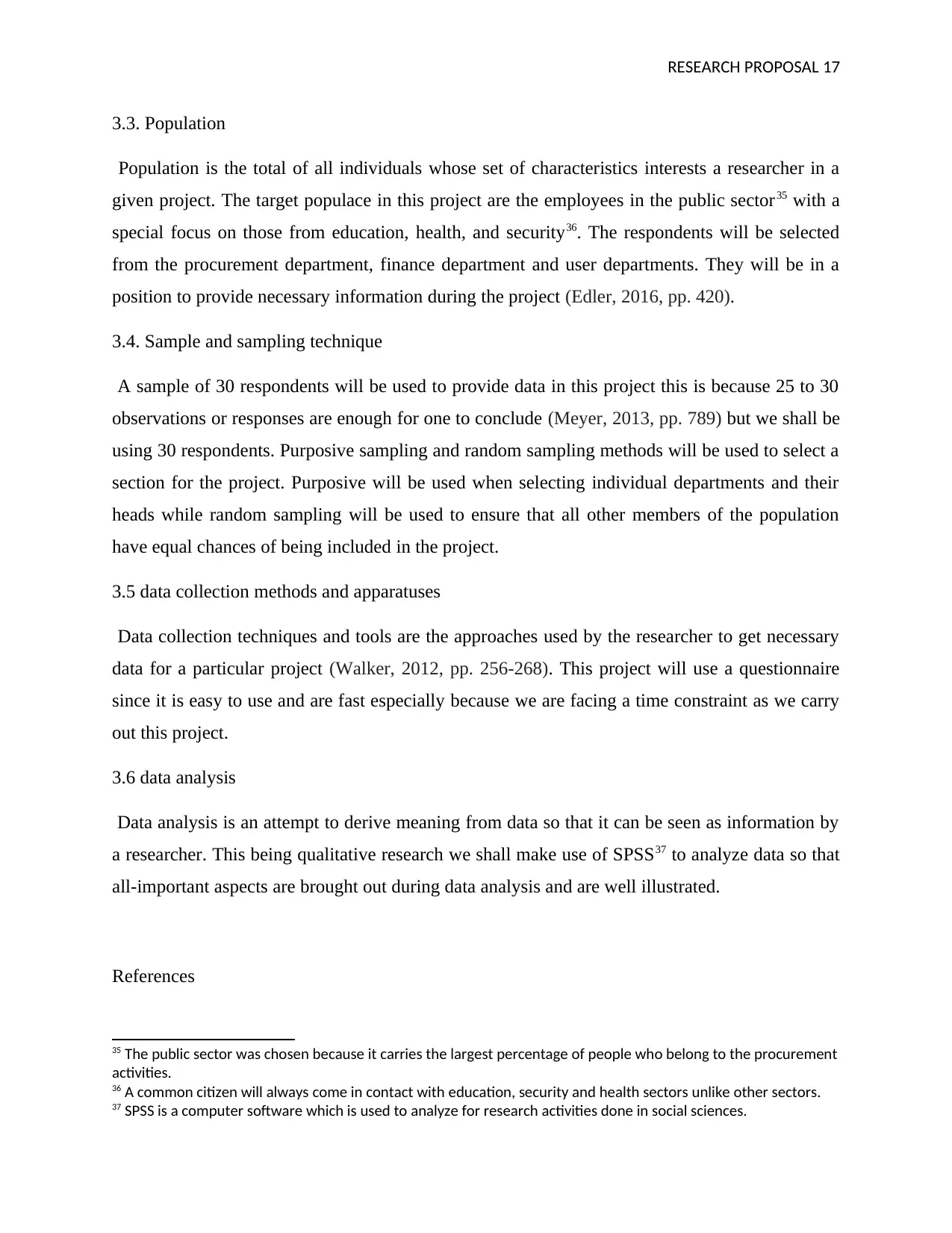
RESEARCH PROPOSAL 17
3.3. Population
Population is the total of all individuals whose set of characteristics interests a researcher in a
given project. The target populace in this project are the employees in the public sector35 with a
special focus on those from education, health, and security36. The respondents will be selected
from the procurement department, finance department and user departments. They will be in a
position to provide necessary information during the project (Edler, 2016, pp. 420).
3.4. Sample and sampling technique
A sample of 30 respondents will be used to provide data in this project this is because 25 to 30
observations or responses are enough for one to conclude (Meyer, 2013, pp. 789) but we shall be
using 30 respondents. Purposive sampling and random sampling methods will be used to select a
section for the project. Purposive will be used when selecting individual departments and their
heads while random sampling will be used to ensure that all other members of the population
have equal chances of being included in the project.
3.5 data collection methods and apparatuses
Data collection techniques and tools are the approaches used by the researcher to get necessary
data for a particular project (Walker, 2012, pp. 256-268). This project will use a questionnaire
since it is easy to use and are fast especially because we are facing a time constraint as we carry
out this project.
3.6 data analysis
Data analysis is an attempt to derive meaning from data so that it can be seen as information by
a researcher. This being qualitative research we shall make use of SPSS37 to analyze data so that
all-important aspects are brought out during data analysis and are well illustrated.
References
35 The public sector was chosen because it carries the largest percentage of people who belong to the procurement
activities.
36 A common citizen will always come in contact with education, security and health sectors unlike other sectors.
37 SPSS is a computer software which is used to analyze for research activities done in social sciences.
3.3. Population
Population is the total of all individuals whose set of characteristics interests a researcher in a
given project. The target populace in this project are the employees in the public sector35 with a
special focus on those from education, health, and security36. The respondents will be selected
from the procurement department, finance department and user departments. They will be in a
position to provide necessary information during the project (Edler, 2016, pp. 420).
3.4. Sample and sampling technique
A sample of 30 respondents will be used to provide data in this project this is because 25 to 30
observations or responses are enough for one to conclude (Meyer, 2013, pp. 789) but we shall be
using 30 respondents. Purposive sampling and random sampling methods will be used to select a
section for the project. Purposive will be used when selecting individual departments and their
heads while random sampling will be used to ensure that all other members of the population
have equal chances of being included in the project.
3.5 data collection methods and apparatuses
Data collection techniques and tools are the approaches used by the researcher to get necessary
data for a particular project (Walker, 2012, pp. 256-268). This project will use a questionnaire
since it is easy to use and are fast especially because we are facing a time constraint as we carry
out this project.
3.6 data analysis
Data analysis is an attempt to derive meaning from data so that it can be seen as information by
a researcher. This being qualitative research we shall make use of SPSS37 to analyze data so that
all-important aspects are brought out during data analysis and are well illustrated.
References
35 The public sector was chosen because it carries the largest percentage of people who belong to the procurement
activities.
36 A common citizen will always come in contact with education, security and health sectors unlike other sectors.
37 SPSS is a computer software which is used to analyze for research activities done in social sciences.
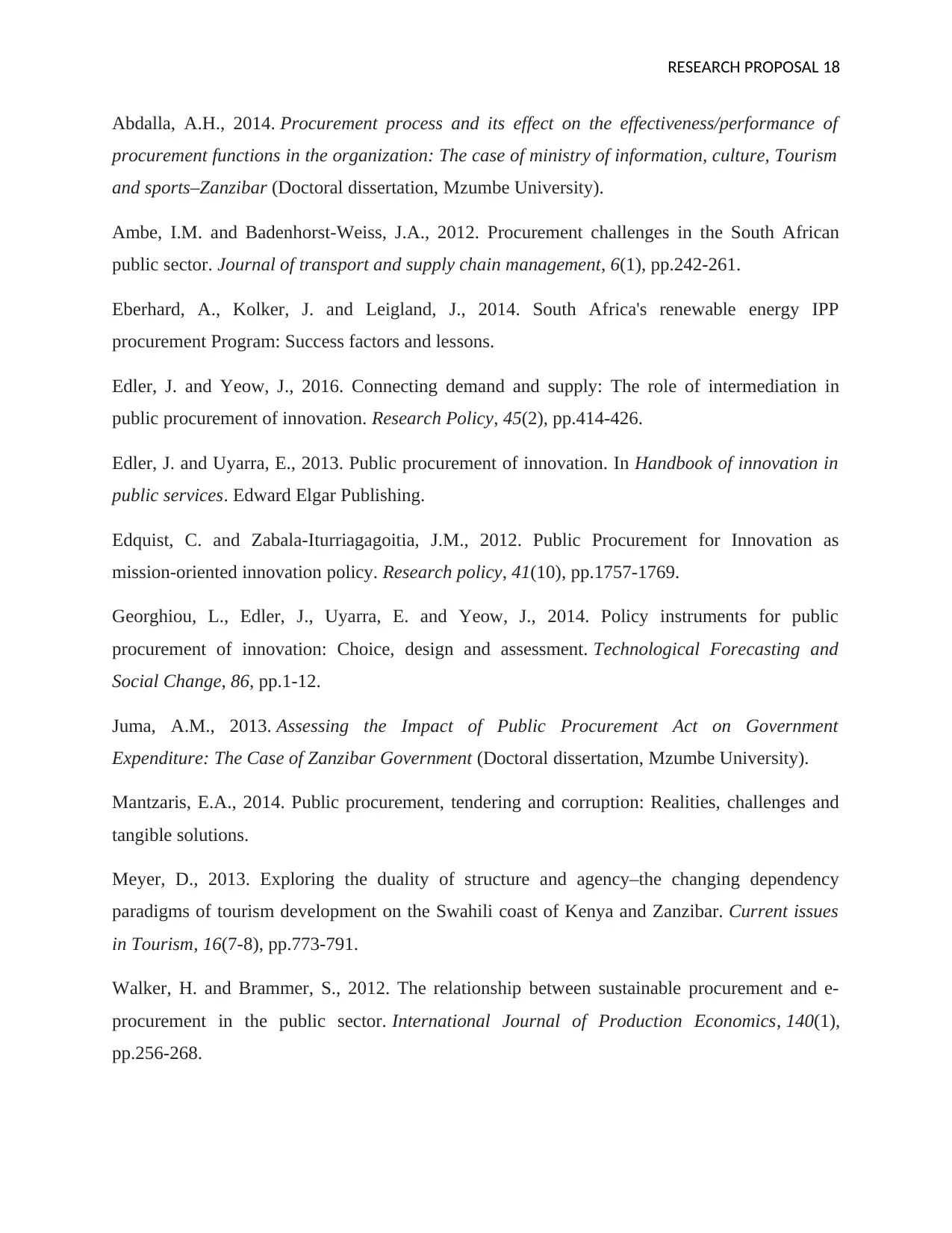
RESEARCH PROPOSAL 18
Abdalla, A.H., 2014. Procurement process and its effect on the effectiveness/performance of
procurement functions in the organization: The case of ministry of information, culture, Tourism
and sports–Zanzibar (Doctoral dissertation, Mzumbe University).
Ambe, I.M. and Badenhorst-Weiss, J.A., 2012. Procurement challenges in the South African
public sector. Journal of transport and supply chain management, 6(1), pp.242-261.
Eberhard, A., Kolker, J. and Leigland, J., 2014. South Africa's renewable energy IPP
procurement Program: Success factors and lessons.
Edler, J. and Yeow, J., 2016. Connecting demand and supply: The role of intermediation in
public procurement of innovation. Research Policy, 45(2), pp.414-426.
Edler, J. and Uyarra, E., 2013. Public procurement of innovation. In Handbook of innovation in
public services. Edward Elgar Publishing.
Edquist, C. and Zabala-Iturriagagoitia, J.M., 2012. Public Procurement for Innovation as
mission-oriented innovation policy. Research policy, 41(10), pp.1757-1769.
Georghiou, L., Edler, J., Uyarra, E. and Yeow, J., 2014. Policy instruments for public
procurement of innovation: Choice, design and assessment. Technological Forecasting and
Social Change, 86, pp.1-12.
Juma, A.M., 2013. Assessing the Impact of Public Procurement Act on Government
Expenditure: The Case of Zanzibar Government (Doctoral dissertation, Mzumbe University).
Mantzaris, E.A., 2014. Public procurement, tendering and corruption: Realities, challenges and
tangible solutions.
Meyer, D., 2013. Exploring the duality of structure and agency–the changing dependency
paradigms of tourism development on the Swahili coast of Kenya and Zanzibar. Current issues
in Tourism, 16(7-8), pp.773-791.
Walker, H. and Brammer, S., 2012. The relationship between sustainable procurement and e-
procurement in the public sector. International Journal of Production Economics, 140(1),
pp.256-268.
Abdalla, A.H., 2014. Procurement process and its effect on the effectiveness/performance of
procurement functions in the organization: The case of ministry of information, culture, Tourism
and sports–Zanzibar (Doctoral dissertation, Mzumbe University).
Ambe, I.M. and Badenhorst-Weiss, J.A., 2012. Procurement challenges in the South African
public sector. Journal of transport and supply chain management, 6(1), pp.242-261.
Eberhard, A., Kolker, J. and Leigland, J., 2014. South Africa's renewable energy IPP
procurement Program: Success factors and lessons.
Edler, J. and Yeow, J., 2016. Connecting demand and supply: The role of intermediation in
public procurement of innovation. Research Policy, 45(2), pp.414-426.
Edler, J. and Uyarra, E., 2013. Public procurement of innovation. In Handbook of innovation in
public services. Edward Elgar Publishing.
Edquist, C. and Zabala-Iturriagagoitia, J.M., 2012. Public Procurement for Innovation as
mission-oriented innovation policy. Research policy, 41(10), pp.1757-1769.
Georghiou, L., Edler, J., Uyarra, E. and Yeow, J., 2014. Policy instruments for public
procurement of innovation: Choice, design and assessment. Technological Forecasting and
Social Change, 86, pp.1-12.
Juma, A.M., 2013. Assessing the Impact of Public Procurement Act on Government
Expenditure: The Case of Zanzibar Government (Doctoral dissertation, Mzumbe University).
Mantzaris, E.A., 2014. Public procurement, tendering and corruption: Realities, challenges and
tangible solutions.
Meyer, D., 2013. Exploring the duality of structure and agency–the changing dependency
paradigms of tourism development on the Swahili coast of Kenya and Zanzibar. Current issues
in Tourism, 16(7-8), pp.773-791.
Walker, H. and Brammer, S., 2012. The relationship between sustainable procurement and e-
procurement in the public sector. International Journal of Production Economics, 140(1),
pp.256-268.

RESEARCH PROPOSAL 19
1 out of 19
Related Documents
Your All-in-One AI-Powered Toolkit for Academic Success.
+13062052269
info@desklib.com
Available 24*7 on WhatsApp / Email
![[object Object]](/_next/static/media/star-bottom.7253800d.svg)
Unlock your academic potential
© 2024 | Zucol Services PVT LTD | All rights reserved.





